Amateur Radio Public Seismic Network
NOTE 202109.21: Due to fire & floods there is no "Current Seismicity".
I am attempting to rebuild another PSN from the pieces I have left.
The original Redwood City PSN is now located at:
PSN Heliplots can be observed here:
http://www.seismicnet.com/currentseismicity.html
Adobe; without regard to anyone's work or content, scuttled FLASH!
I am working on a fix to replace all ARPSN Flash Animation; if possible.
Audio Control
Stop Play
VolksMeter Channel One & Two - 200902.11
Text size can increased/decreased using + and - keys, while, on a PC: pressing and holding control key and on a Mac: pressing and holding command (Apple) key.
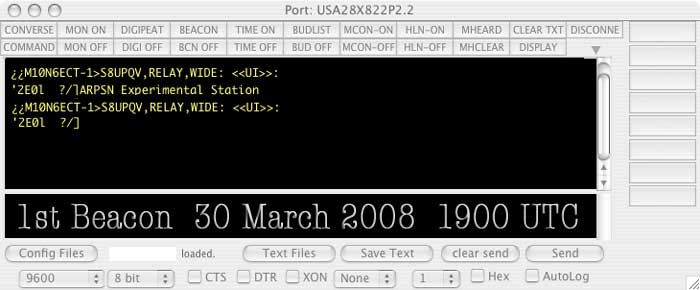
First APRS Beacon - 30 March 2008
![]()
APRS Beacon Location
http://www.findu.com/cgi-bin/find.cgi?call=N6ECT-1
Via: http://www.findu.com/
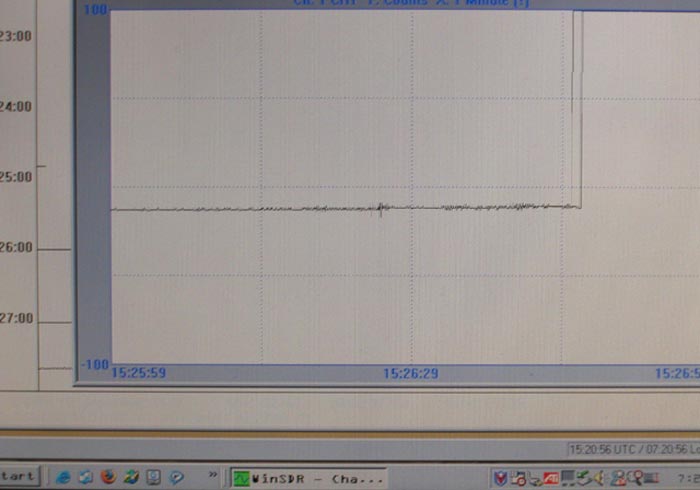
It's Alive!-First
Observed Motion
Last night handshaking occurred when the following message from the sensor appeared on the laptop: 03/31/08 22:03 DLL: Sending Configure Information
While fine tuning the sensor this morning (200804.01) Input Avg: 0 was achieved.
((fwiw) Obtaining zero was personal choice; taking a little over eight hours. The actual (listed) tolerance is broad (+/- 500 for one sensitivity adjustment and +/-100, +/-50, and +/-10 for other adjustments. My original 'within tolerance' adjustments (+/-38) were completed in 37 minutes; well within the stated +/-50 tolerance.)
With Input Avg: zero and Y-scale set to 100 I watched from a distance for about 39 minutes and decided to make a cup of coffee.
I was amused when my coffee grinder (while grinding) and espresso machine (while steaming) triggered massive seismic events on my laptop screen. (-;
For the fun of it, i cranked up X-scale to one (1) and could could detect the dog and cats walking on the carpeted floor in the hall and living room (two rooms away).
The documentation says the sensor control program is supported for Win XP, 2000, or VISTA. Currently (200804.03) I am looking for a rugged (that will have to live outdoors), used, laptop running XP Pro.
In the meantime, I was able to get the VolksMeter functioning on the serial port (RS232) of an old Win98, Compaq Presario 1685 laptop; rather than the USB port, which (imo) Win98 does not know how to handle.
(200804.03)

N6ECT-1
ARPSN Seismic Data Station 1
Cleaned shed in preparation for permanent ARPSN/APRS operation.
Decided to re-paint the building with lighter color and am considering trying paint that allegedly insulates exterior hot and cold temperatures.
I may also add solar exhaust fans that will not produce noticeable vibration, maybe some new-tech insulation I read about, and the Beacon continues "Off-Duty".
(200804.04)
Added picture of Garmin etrex model H, which I normally use when going into deep woods, because it saved me considerable time installing GPS for the VolksMeter.
The first episode occurred while installing the Garmin GPS 16/18, which I call, "GPS hockey puck," into the VolksMeter.
No matter how many times I repositioned the 16/18 (surrounded by tall trees) I could not get a lock (L) on WinSDR (the control program) and this is when I grabbed the etrex.
The etrex located a signal within moments, about 4 feet from the 16/18 and I repositioned it, and saw a lock (L) on the WinSDR screen and a quick check told me I was tracking 6 satellites. I went back to the 16/18 and started moving the etrex around, saw the etrex signal double approximately 2 inches South of the current position of the 16/18 and repositioned it. The computer now showed tracking 9 satellites, and I checked the Enable Location Averaging box to accumulate data.
The second episode occurred while in the process of moving the sensor to its fixed location, where I was able to pinpoint a GPS signal in about 5 minutes with the etrex and position the 16/18.
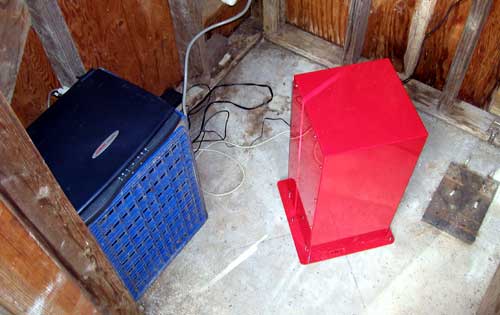
ARPSN
# 1 Operational 04 April 2008 2200 UTC
Installed single N/S sensor and was 'up and running' at 3 PM PDT, April 4th.
ARPSN-1 is currently undergoing a seven day shake-down environmental test in full operational mode.
Everything went smooth today during the 3rd and (for now) final fixed installation of ARPSN-1.
At 10:30 AM, after setting 'everything' up (IA = +/-7) and while standing up to take a break, I lightly bumped the top of the sensor with my elbow; at which point, 'my anal side kicked in'.
Between 10:30 AM and 3 PM, I bumped the sensor, by accident, a total of five (5) times ... and am one of those folks who know, ''once it works, it usually continues to work,' so I started from the beginning each time, doing alignments as close to +/-0. (otoh) The plus side was, I have now memorized a little over half the manual (-;
As mentioned above, the etrex was an asset in setting up the GPS 16/18, which is currently tracking ten (10) positioning satellites.
I have paperwork to get done during the next seven days and if I receive any notable seismic data, during this time, pictures of activity will be placed on an easy access page.
I will post a location teaser on the N6ECT-1 ARPSN beacon, soon.
I am still considering how I will return WinSDR data to the house and will probably run a test using a long ethernet cable I have stashed away, somewhere.
My other alternative is trying a long USB cable to an old XP tower and if that works, get a used XP laptop. (btw) We have cut power usage (here) forty-two percent (42%) by moving from large machines to laptops and Mac Mini computers.
(9:30 pm pdt) Around 6:30 pm I noticed some USGS activity and decided to see if ARPSN-1 recorded any events (activity was close).
When I got there I discovered I must have pushed the display too far down, when I finished at 3 pm, and had shut off the computer off by accident.
On restart, I was pleased to see a IA = +7 and started data collection.
Guess what happened next?
I am tired and when I attempted to stand up, my elbow (for the 6th time) bumped the sensor.
I re-calibrated and was back on-line at 9 pm. [Note to Self: Accept given tolerances rather than anal, 'near zero', self-imposed, tolerances.] (-;
(200804.05)
Checked seismic data collection this morning and event recording is operational. (: Replaced N6ECT-1 "ARPSN Seismic Data Station 1" Beacon with "flyingsnail.com/seismic.html" - seismic.html - Welcome APRS visitors!
(200804.07)
In process of upgrading 1RU to 2RU using a VMII-2CUG (2nd channel upgrade kit).
The kit consists of a pendulum, sensor, and damper assemblies, cables, all hardware necessary to mount assemblies to unused post of 1RU (channel unit).
The kit will allow full North/South/East/West detection with the VolksMeter (ARPSN 1 is currently running one N/S sensor.) and will provide better data reporting for ARPSN [A VMII-2CUG assembly page will be added with pictures.]
I noticed this morning ARPSN 0001 event collection was almost equal to USGS reporting and the 2nd sensor should narrow that. Here is the location of the USGS page I check often:
http://quake.usgs.gov/recenteqs/Quakes/quakes0_fault.htm
and here is an example of where I am considering setting the point (magnitude 3) at which ARPSN issues an alert (in my area) via the APRS network:
http://quake.usgs.gov/recenteqs/Quakes/quakes.big_fault.htm **
(200804.09) I noticed the D700A shut itself off yesterday afternoon, and it is on an APC UPS, which did not indicate a 'power out'. I have read about these shutdowns and pressing the power button restored operation (this morning).
I changed the N6ECT-1 beacon to ARPSN-1 Seismic Alert System and will start broadcasting magnitude 3, or above, seismic activity; (imo) a small amount of activity, which is presented in this link **
ARPSN-1 is a "fixed station" running WIDE2-2 - PACKET PATH and my intention is to beacon once per 24 hours; unless there is 3 Magnitude, or greater, seismic activity, based on the following information:
Fix #6, Proportional Pathing for Trackers:
The original APRS design uses a Decaying Algorithm to send new data more frequently than old data, and make each later copy less and less often if the packet is unchanging. Most follow-on APRS clones, and trackers ignored this fundamental principal and transmit far too much duplicate unchanging info. . We need trackers to use direct and local 1 hop paths more often than 2 or 3-hop paths. . I call this Proportional Pathing
http://web.usna.navy.mil/~bruninga/aprs/fix14439.html
Another thing I would like to implement in ARPSN, for reporting purposes, is something mentioned by Bob Bruninga, WB4APR:
APRS
Common Bulletin Board for Situational Awareness
16 Jan 2008 - WB4APR
http://web.usna.navy.mil/~bruninga/aprs/bulletinBoard.txt
I have been reading too much and my right eye is starting to blur again, so I will attempt to divert my attention elsewhere, which brings me to today's project, 'isolating ARPSN-1's main sensor'.
If all goes as expected, I will be able to return the laptop, from the seismic shed to, the house, and have resurrected an old XP PRO tower, that will serve as ARPSN 'back-up', but we will see... and I will report later. (fwiw) This move, if successful, will allow me to begin uploading seismic images and data to the seismic page.
Finally, if one emits APRS traffic in Northern California, (imo) this is a good site to check, frequently:
http://www.norcalaprs.net/usagex.html
(200804.10)
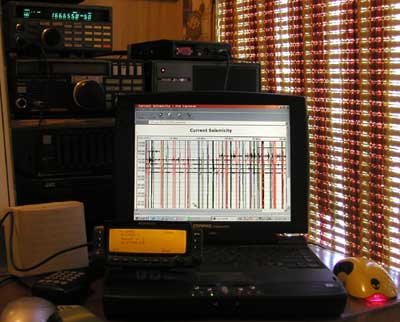
Yesterday I was able to move ARPSN-1's laptop to my main computer room with (imo) great success.
The first thing I did was review collected seismic data and was impressed by the number of recorded events.
It took about four hours to compare my results with USGS and ;-) I am feeling more confident.
(fwiw) During my past forty year interest in amateur seismology I have not paid much attention to teleseismic events, because I have been more interested in local activity.
For testing purposes, I "Enabled" (with supplied settings) "Teleseismic Event Detection", with ADC Bits: 24, SPS: 10, and was amused when I discovered one of the events recorded was this one:
Magnitude
7.3 - LOYALTY ISLANDS
http://earthquake.usgs.gov/eqcenter/recenteqsww/Quakes/us2008qqa2.php#details
Another thing I noticed was 'software tuning' of the sensor improved greatly with the laptop now considerable distance away from the 1RU.
Currently I'm testing ADC Bits: 20, SPS: 20.
When I install the E/W sensor, I may rebuild the seismic shed, because I feel it may be to tall and catches wind blowing up from the canyon below. As it stands, it is seven feet, five inches tall and my idea is to make it four feet tall and insulate it.
Although I detected the magnitude 3.8 event in Petrolia, California, at 7:17:34 this morning, I did not broadcast it via APRS, because I was not prepared and, to be honest, am more into verification than reporting, at this point.
Finally, I am adding a RSS feed for this page, so those who use feeds will know when I have added something new. In elder days I used Un*x "finger", but Nobody seems to use that anymore (-;
(200804.12)
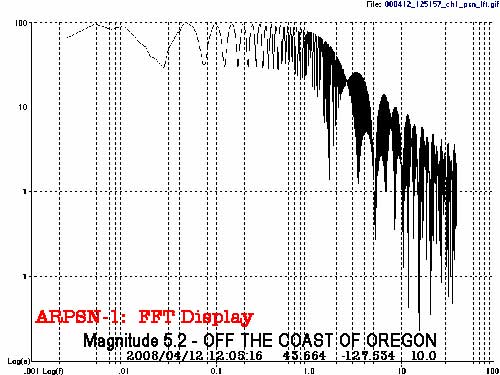
The above image is a FFT display of the M 5.2 Off the coast of Oregon (received N/S) and here are the details:
http://earthquake.usgs.gov/eqcenter/recenteqsww/Quakes/us2008qtbd.php
More later == dealing with Windows 98 MFC42.DLL problem that had nothing to do with operation of the VolksMeter II or WinQuake/WinSDR software. I fixed it and am defragging the disk as I type.
(200804.13)
A catch-up on what happened yesterday and a Windows 98 MFC42.DLL fix that worked for me:
I ASSUME, while using Start -> Settings -> Control Panel -> Add/Remove Programs, to clean up 'unused' programs (freeing disk space), one of the Uninstall programs removed MFC42.DLL from C:\WINDOWS\SYSTEM\.
Using, Start -> Find -> Files or Folders -> Named -> MFC42.DLL, and my main disk drive, I 'right clicked' each MFC42.DLL file found and Renamed it MFC42.old (If you have MFC42.DLL in C:\WINDOWS\SYSTEM\, leave it alone, and see if the problem goes away after a restart. (fwiw) I did NOT have MFC42.DLL on my drive.).
I replaced the missing C:\WINDOWS\SYSTEM\MFC42.DLL with one located on my '98 Second Edition Updates' disc at: E:\drivers\audio\aureal (there is another MFC42.DLL located at: E:\add-ons\pws), rebooted, and everything was back 'to normal'.
I spent the first three hours yesterday morning verifying recorded events (since the last time I cleared 'event number') and finished verifying recent 'Saved Events' with USGS. Every event had a match and if I can ;-) resist changing voltages and samples (-; I will post a Channel One (N/S) image.
I also seem to be 'cramming' a lot of teleseismic information because it is both new and fascinating, thanks to my adventure with the VolksMeter.
(200804.14)
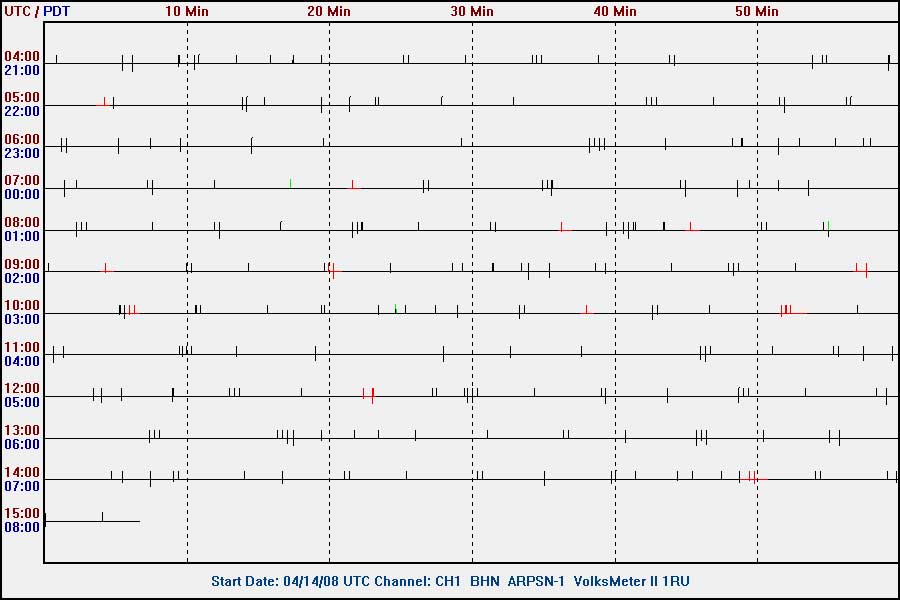
ARPSN-1 VolksMeter
1RU - CH1 display 200804.14

Screenshot of current WinSDR window 200804.14
Added screenshot of ARPSN-1 Channel One Display (click image for larger picture) and added screenshot of how I am currently using WinSDR.
Today I am cleaning up my electronics workbench in preparation for the arrival of the E/W sensor.
(200804.15)
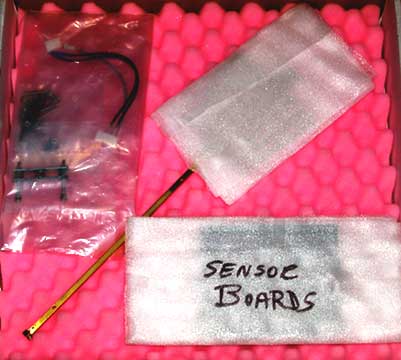
The 2CUG kit arrived yesterday and assembly will begin as soon as it warms up here. The current temperature is 36.9F degrees or 2.7C on the front porch and 34F outside.
Last night we had some strong wind and I noticed it had an effect on the VolksMeter II.
After observing weather conditions on the effect of the VMII sensor in the seismic shed, I have decided to rebuild part of the shed to take it off the concrete slab, where is is currently fixed/attached, and causes excess vibration when strong wind blows. Here is my new idea:

Also, I will be adding a weather station for Seismic Station reference and will eventually connect it to the APRS network.
(200804.16)
Assembling
VolksMeter II - 2CUG Kit
"And I did it my way" -
Sid Vicious
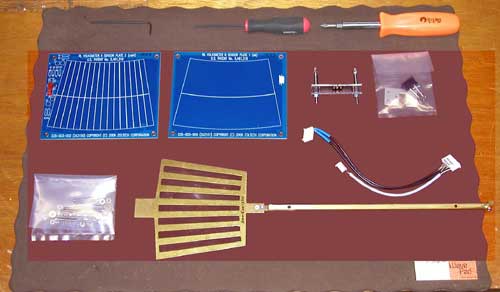
2CUG Kit Highlighted - Tools part of original
1RU
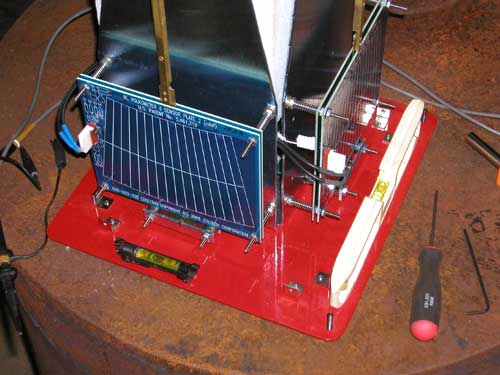
Final
Test Alignment
(200804.17)
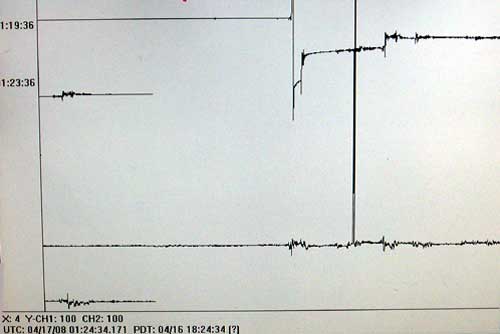
VolksMeter
II - 2RU Ready for Permanent Install
Completed assembly of 2CUG Kit and ready for permanent install. Pictures and notes located at:
http://www.flyingsnail.com/AmateurRadio/assm2cug.html
I am currently deciding what to do about the seismic shed.
(fwiw) Adding a second sensor was easy and if I had it to do over again, I would have ordered the 2RU first because I got snagged on LFEs (Low-Frequency Earthquakes) and Teleseismic Events, which I will report on later.
P.S. The last time I had this much fun was twenty-eight (28) years ago, when I was involved with the Pacific Packet Radio Society - PPRS !!!
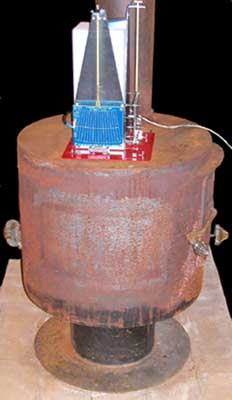
(Trivia) The 2RU is sitting on a level wood stove (in the studio) that is made out of injection tubing & plate, and has it's own foundation.
I've had the 2RU apart numerous times, have reset everything for the best possible signal receive, and am currently looking for low-frequency activity. (Low-Frequency Earthquakes (LFE) is a fascinating subject that may lead to an 'early earthquake detection/warning system'.)
I am impressed with the 2RU's performance and intend to install it (in the shed) tomorrow; despite wind, because the shed needs more consideration.
I am also considering moving ARPSN to a geophone (covers local events) and establish the new sensor as my original PSN concept.
(200804.20)
On Friday, 200804.18, VMII-2RU was installed in the (non-modified) seismic shed.
If one is curious why the shed was not modified before the install, a simple answer is, 'anxious anticipation of data retrieval' and the complex answer is, 'LFE/teleseismic activity observed in the hours leading up to the install,' which enhanced my new 'LFE wrinkle' (wrinkle = fascination with 2RU's teleseismic/LFE capabilities) and here is what that means (imo).
The VolksMeter is more handy (to me) as a research tool, rather than being put into Amateur Radio service to cover local earthquake events; however, all sensor data (collected here) will be eventually provided on Flying Snail's PSN page (seismic.html).
Within the next few weeks, I will install a Mark Products 4.5 Hz 3 Component L15B Sensor, which will be incorporated into ARPSN-1, for LOCAL EVENTS. Below is a data sheet with pictures:
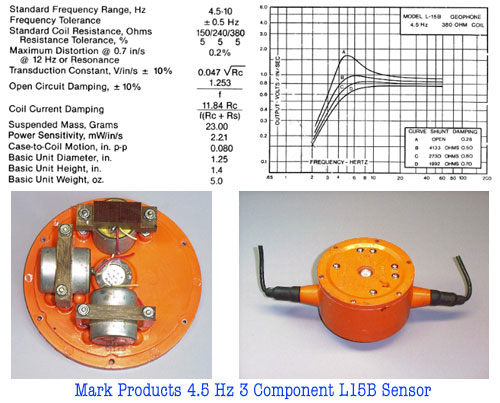
In order to provide more accurate results, installing a weather station has been added to the 'to-do' list, and will be incorporated into N6ECT-1/ARPSN-1.
A weather station will be used to monitor/measure environmental conditions surrounding the seismic shed, with an inside (shed) temperature monitor.
During most of the weekend I have been evaluating, analyzing, and comparing seismic data. Here are some recent 'snaps', first image = North/South sensor and second image = East/West sensor:
Channel 3 - ADC: 16v - SPS: 80
![Start: 04/19/08 - VolksMeter II 2RU Velocity [Integrated] Data Channel 1 - N/S Start: 04/19/08 - VolksMeter II 2RU Velocity [Integrated] Data Channel 1 - N/S](20080420ch3.gif)
04/19/08 - VolksMeter
Velocity [Integrated] Data Channel 1 - N/S - Large
Image
Channel 4 - ADC: 16v - SPS: 80
![Start: 04/19/08 - VolksMeter II 2RU Velocity [Integrated] Data Channel 2 - E/W Start: 04/19/08 - VolksMeter II 2RU Velocity [Integrated] Data Channel 2 - E/W](20080420ch4.gif)
04/19/08 - VolksMeter
Velocity [Integrated] Data Channel 2 - E/W - Large
Image
I will eventually change the way data is displayed on the twenty-four (24) hour charts and include CH1/CH2 Accelerated images. I selected the above display format to allow for easier cross reference verification with 'outside sources'.
Honestly speaking, at this point (imo), the VolksMeter will require about three months of testing before being placed in 'active service'; whereas, the ARPSN-1 L15B sensor will take less than a month.
I have alternative seismic systems (currently operating) that may, temporarily, be placed in service for ARPSN-1, but have not decided, yet.
Finally, some may be interested in our local terrain, which sits in a highly seismic area:
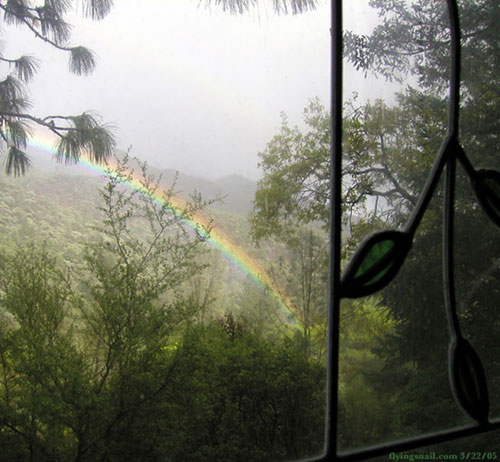
Images located at:
http://flyingsnail.com/Garden2003/index.html
http://flyingsnail.com/firewatch.html
(200804.23)
There are some things that need seriously to be clarified concerning theory of seismometers, since there is so much confusion; not only among amateur seismologists, but also even many professional geoscientists.
Ultimately, the ONLY source of seismograph excitation (no matter the instrument design) is ENERGY. Additionally, the ONLY thing that delivers energy to the seismometer is Earth's ACCELERATION at the site of the instrument. This is true not only for the instrument's response to earthquake waves whose periods are shorter than about 300 s, but also for earth 'hum' in which the instrument responds mainly to tilt, when the periods are greater than about 300 to 1000 s. Dr. Randall D. Peters - Department of Physics, Mercer University, Macon, Georgia.
I have been immersed in the writings of Randall D. Peters and have attempted to devour every word ;-) especially his 'debunking material (-; (which I can relate to). Excellent reading, and if one is curious about my direction with the VolksMeter, this is the place to browse. - http://physics.mercer.edu/
The below (green) was written yesterday (200804.22) before I updated WinSDR from v4.1.2 to v4.1.4 and lost 'all' of my event files. (fwiw) The majority of my computer experience is based on Unix, I tend to get "\" and "/" confused under Windows, and it was my error that caused the data loss.
As I sit here, I can look over my shoulder at the last hour of recorded seismic activity and can match major activity, here, with everything listed at USGS:
http://earthquake.usgs.gov/eqcenter/recenteqsww/Quakes/quakes_all.html
and have a great (imo) FFT of the M-5.9 located off the East coast of Honshu, Japan (I am currently running ADC: 20, SPS: 25), which I may post tomorrow.
For those monitoring N6ECT-1/ARPSN-1 (APRS), I have decided to 'up the Magnitude' to: '4 and above' (local), for the moment, and will explain later. All I need to do is connect a cable, and my data will start uploading, but I still have some things to 'work out', before that happens.
I have decided to create a special housing for the VolksMeter in order to allow for its 'full potential and am not in a hurry (current data keeps me 'into the screen' and taking notes).
If it warms up, and all goes well, I should have the L15Bs' on-line this weekend and (perhaps), start APRS alerts.
(200804.24)
L15B - A/D & Amp. Filter - L15B
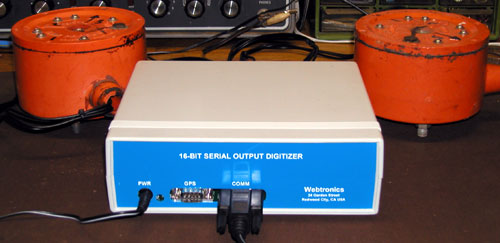
Mark Products L15Bs', etc., ready for install, tomorrow, if the weather warms up, and these are the sensors intended for LOCAL seismic APRS alerts.
(200804.28)
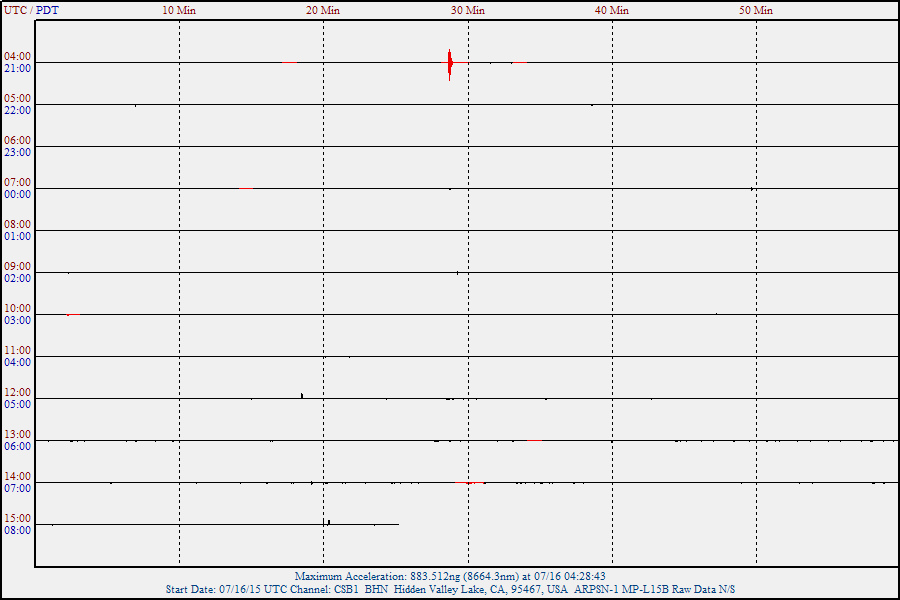
Mark
Products 4.5Hz L15B Sensor North/South Acceleration - SPS: 50 - Updating
image
L15B heliplots available here: http://www.flyingsnail.com/seismic.html
(200804.30)
The above is a screenshot of Northern California APRS traffic at around 9 pm pdt 200804.29.
It was produced by a free APRS Windows program titled: UI-View16 (There is an UI-View32 APRS client available.) and you can read about it here:
(200805.01)
On the 25th of April I was diverted by a 'wrinkle in the system', worked until yesterday to resolve it, and the only thing I regret is not being able to 'launch a beacon' for the M 5.2 earthquake in Willow Creek, CA, near Eureka.
All sensors are working fine and the only thing I need to do is get the L15Bs off network time and on their own gps.
The VolksMeter is running at a new location and is collecting 'lots of data", which keeps me busy. Eventually I will put images up, but am doing what I call 'fine tuning' ...at the moment, and will eventually get around to pictures.
Yesterday marked the 30th day of this project and I need a day off (-;
(200805.05)
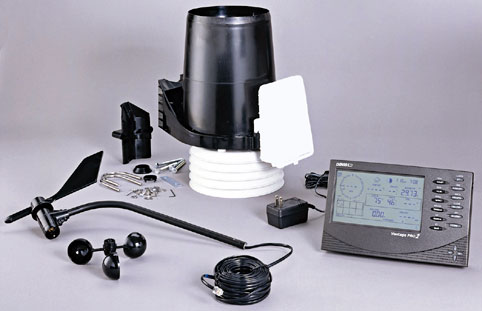
Adding Davis 6152c (cabled) Weather Station to N6ECT-?/ARPSN-1 (an aid for 'fine tuning', to associate with seismic data) and pictures will be added under a 'future', to be constructed, weather page.
The Davis was selected because of accessories and ease of upgrading. In due process, I will include a section on building a home-made weather station.
I have not decided on which software I will use and that will be added later.
I managed to get the L15B package (the main sensors for ARPSN) functioning with the Garmin GPS and images are currently being uploaded to the seismic page.
(fwiw) Uploading data (for me, at this point) is a PITA because we use secure access (ssh/sftp) and most Windows software does not address this. In turn, I (for personal reasons) upload all pertinent Windows data into an 'iron box', that scans input/output/etc. for 'nasties', and then sends checked data to a machine that uploads it securely, to my pages. Yes, there is (what I call) 'work-around software', which establishes a sftp shell, but rarely comes with source, and I don't have time to 'monitor it'.
(200805.07)
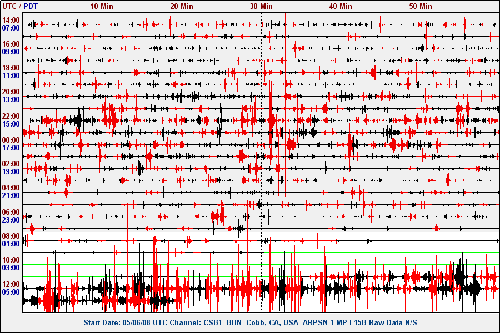
The highlighted area, in the above image, is a good example of why a weather station is being included in the ARPSN project and will explain part of my concept of 'fine tuning' in regard to seismic stations.
The large traces above; including the highlighted area, are due to wind noise (very strong wind on the seismic shed, which is still bolted to the concrete slab) and a weather station will help me properly insulate wind noise in the new shed, which I am now considering changing from wood to filled concrete block (think bunker).
Today, around 02:30 AM PDT (green line in above image), there was a BSOD (Blue Screen of Death) on the computer running ARPSN-1 (L15B package); after 12 days of error free operation since installation, and here is what happened leading up to Microsoft's error message:
If you recall (written above 200804.13) I had an incident with Windows 98 MFC42.DLL, was 'being nice' when I explained it, and the reason I am bringing it up again, is because I turned Microsoft's Automatic Updating OFF on both machines, when that happened.
Yesterday, I noticed there was a XP update (SP3), clicked Install, clicked Accept, and the download began.
It consumed about an hour of downloading time and produced an error which told me to check 'software download history' to discover why the error happened == and there was NO explanation as to why the error occurred, there.
I closed MSIE on the software update history page and clicked "Windows Update" again, only to have the same thing happen; which, in total, repeated the same error three times. I gave up and went to bed.
When I got up this morning, a BSOD was on my screen, and a weird boot screen when it started, so I restarted Win XP PRO and WinSDR again, with hopes this does not happen again. (fwiw) This machine was/is only allowed on the Internet to collect Microsoft updates, was originally intended as a 'game machine', until I switched to a PS-2, and worked great until the first SP1 update, at which point, most of my games stopped working and I had to reload the original XP discs to get them back.
When XP SP2 was announced, I waited for six months to see what was being said about the update before I tried it myself, and after installing it, the games still worked; however, a chunk of RAM disappeared, even though the RAM and MB (swapped) check out fine, so I retired the machine and it was moved into storage for a future project.
I brought the 'game machine' back into service (for the VolksMeter) with a fresh XP software install up to and including SP2, with all current updates, and noticed the missing memory returned. So, without incident, I've used this machine with SP2, for around a month, with no problems
After this mornings error incident with BSOD, I attempted another SP3 update, it presented me with a new 'acceptance window', which I accepted, and it started the 66+ MB download again, consumed about x? hours downloading time, and the current images, on the seismic page, were created under it.
((fwiw) There is NO high speed Internet (here) in our small populated (12 families), AT&T based, rural area; however, 3 miles North or 5 miles South, where the population is over one thousand, there is high speed access... and (fwiw), because of trees, which I will NOT cut down and winter weather, satellite does not work well here, ...and don't get me started because I worked with Nick Marshall, W6OLO, for four years (Starquest). ...and Nobody wants "historic" QAM experiments allowing for advanced remote control brought up (-;)
11:00 AM PDT - Just to be fair, I took ARPSN seismic data collection off-line (for a while), looked around, a bit, at the 'new stuff', checked to see if any new updates had been listed on the update page (none), verified SP3 had indeed, been loaded (yes), rebooted the machine, missing RAM was back, uploaded recent seismic activity, wind is slowing down, and 'noise' on the gifs is reducing.
It looks as if 'things' may have gone back to "normal"; a term Nobody wants to define (-;
(200805.12)
The Vantage Pro2 is ready for outside installation (maybe tomorrow) and N6ECT-2/ARPSN-1 WX (weather) data could be available by this weekend, ...if all goes as planned.
I decided to use "WeatherLink" APRS software (6540) with the Davis VP2 and information about it will be added to the 'upcoming' weather page.
(200805.13)
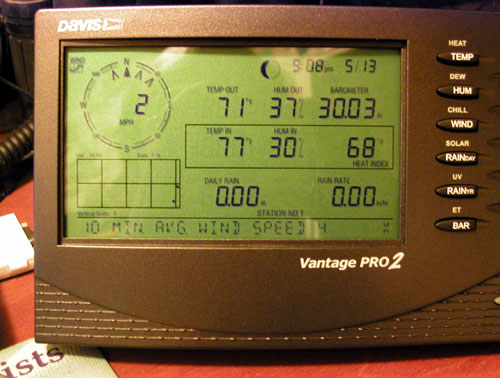
Davis Vantage Pro2 operational and software will be installed soon (I found a 12 volt PC with 6 serial ports I am exploring).
(200805.15)
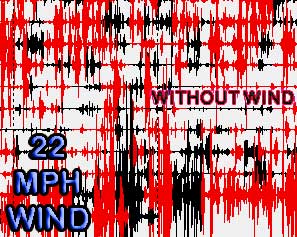
The above image reflects '22 MPH wind' and 'no wind' on the seismic shed and will be used to compare new shed vs. old.
I have not installed WeatherLink software or APRS WX yet, because I am waiting for some parts.
I anticipate the start of construction on a new seismic shed, sans wind noise, this weekend, believe it is fair to give a little more background, at this point. This is something re-published 20 June 1981 on the construction of a magnetic table, in another area of interest (It is in image form because I have not had time to OCR it).
http://www.flyingsnail.com/missingbbs/ct48.html
and of special interest (to me) was the comment, second paragraph from the bottom, that I am considering in regard to noise reduction for the shed frame and will explain later. This is the index for the above page:
http://www.flyingsnail.com/missingbbs/CommuniTree.html
(200805.19)
Equipment I was expecting to show up on Friday never arrived, outside temperature was in the 100s over the weekend, the computer room, due to the towers I moved in for the sensors and WX station, was 102f degrees, and little was completed over the weekend.
If the equipment I am waiting for arrives today, and it is before it gets too hot, ARPSN will shut down for a short period of time while upgrades are incorporated; including installation of WeatherLink APRS.
I tried an experiment with the Davis VP2, hooked up to a Mac G4 tower running 10.3.9, with a Keyspan Serial to USB adapter using WeatherTracker Beta. The beta software had expired and I did not have time to download it again (dial-up was very slow). You can read about WeatherTracker here:
http://www.afterten.com/products/weathertracker/index.html
For 'all practical purposes' ARPSN is almost finished; from a model point of view, and what remains are (imo) 'rough edges', with seismic shed rebuild being number 1 and the paperwork number 2.
(fwiw/repeat) What is manifesting here is actually model construction, which will be used to reconstruct everything mentioned (here) using low-cost 'home-brew' methods. For example, in regard to a WX Station:
TAPR
T-238+MODEM2 Kit - A Low-Cost APRS WeatherStation
http://www.tapr.org/kits_t238plus.html
Tecnologia
Aplicada 1-Wire Weather Station
http://www.aagelectronica.com/aag/index.html
Weather
Software Supporting CWOP/APRSWXNET Protocol
http://home.comcast.net/~dshelms/cwop.html
Rabbit
Powered 1-Wire Weather Station Controller
http://www.lightningnetwork.org/rabbitweather/
XastirWIKI
http://www.xastir.org/wiki/index.php
[XASTIR is FREE for Mac OS X, freeBSD, Linux variants, Solaris, Windows,
etc.]
(200805.20)
Part of the 'stuff' I was waiting for arrived late yesterday afternoon, so I spent the rest of the day and early this morning getting 'another part' of ARPSN completed.
I am still waiting for another piece of equipment to arrive that 'should' tie everything together ...then, there is still 'the shed'.
Recently I posted the following to a group, received a response, and am placing it here as an aid for anyone else with the same ;-) anal (-; need for verification.
On or around February 29, 2008, Kenwood provided an update for the D710A that stated:
Updated items : (Version 1.00 1.01) [February 29, 2008]
Updates the following feature.
Works with the data logger of the "WeatherLink® for APRS, with Streaming Data Logger" (Davis Part No. 06540) [which i have] as well as the data logger of the "WeatherLink® for Vantage Pro2™, Windows, Serial Port" (Davis Part No. 06510SER).
Note : Please set the "BAUD RATE" (Menu No.602) to 9600bps for stable working performance."
https://www.kenwood.com/i/products/info/amateur/tmd710_tnc_update_e.html
I understood the above to mean I can plug the Davis "Data Logger" into the D710A serial port, supply transmit parameters, and WeatherLink will supply the WX stream. ??? Is that correct?
Verification appreciated.
Response:
Yes.
See this link:
http://www.davisnet.com/weather/products/weather_product.asp?pnum=06540
Also see page 29 of the new In-Depth Kenwood Manual for the D710, written by Bob Bruniga:
http://www.kenwood.com/i/products/info/amateur/pdf/TM-D710AE_IDM_R1.pdf
Snips pertaining to my interest from the above PDF:
6.2.1.1 Davis Instruments Corp.
"The weather station, Vantage Pro2 from Davis Instruments can be used with TM-D710A/E or RC-D710."
"WeatherLink for APRS With Streaming Data Logger [There is a sticker on my box that says the previous.] (Davis Part #.06540) is required for TM-D710A/E and RC-D710."
tnx simmoh56
(200805.21)
The equipment part (I needed two weeks ago and not the fault of the company.) arrived early this afternoon and I have been busy; but first, a comment on our recent local weather.
If you recall, due to the 100+ f. degree temperatures (here) last weekend, the seismic shed rebuild got postponed, and the hot temperatures continued; except during the evening, when it cools down on the mountain.
Yesterday it was in the 100s f. again and this morning it was in the 40s f. at the house (upper 30s at the NW corner == not 'normal weather') and currently (0321 UTC) is 56 f. degrees.
[This radical change in temperature reminded me of a place I visited in the Himalayas, where it would be +/- zero during the night and 80 +/- f. degrees during the day.]
Because I am tired, this will be a brief 'catch-up' [more pictures or a new page later].
A used (lease expired) HP/COMPAQ NC6000 - XP-PRO/SP3 laptop (with port replicator) was added to ARPSN-1 along with a QUATECH RS-232, 4 Port PCMCIA Type II card (Part # QSP-100 G) and I have the Davis VP2 running WeatherLink for APRS and the MP L15Bs running on two serial ports of it (QSP-100). The VolksMeter sensors also work on it, and the remaining thing I need to test is the serial connection to the Kenwood D700A with the Kenwood software (tomorrow). The D710A will be discussed later.
I am pleased with WeatherLink and will eventually begin to set up a weather page, associated programs, and feeds.
(fwiw) I put a week's worth of research into the four port serial Quatech PCMCIA (with port replicator total = five (5) RS-232 ports) and my main reason for selecting this device; besides the fact it appears 'to work out of the box as stated,' is because I discovered an Express Card to PCMCIA card converter that will work with newer laptops, in case I want to upgrade to a newer notebook with ample storage, on alternative power.
Proposed and working = ** :
Serial Port #:
1 = free **
2 = L15Bs **
3 = WeatherLink **
4 = VolksMeter (** yes, but no data provided until seismic shed rebuild)
5 = Tm-D700A (untested)
To Be Continued == gn
(200805.22)
Everything (electronic) is still working, I spent most of the day digging a new seismic shed foundation, and got about one quarter (1/4) done.
The slab was originally poured on a large rock and I am using a chisel to remove packed earth, about a foot from the slab, on four sides (for the concrete block foundation) ... and, there will be pictures.
(200805.26)
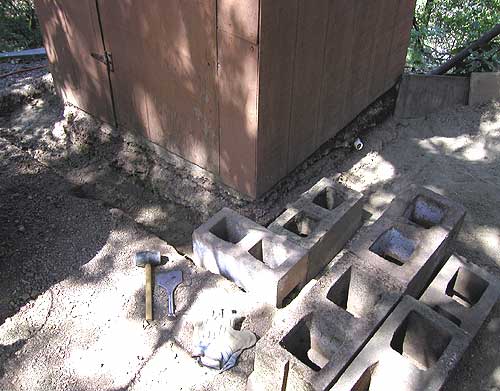
I decided to stick with the original seismic shed plan (above) for the first test and if that does not work, I will move to plan two and build a concrete bunker.
I worked every day (during the holiday) on the new foundation and it was slow. I ended up using a chisel and hammer (pictured) to dig out the trench, which is still not finished, yet.
I let the sensors run while digging the trench, observed only a little sensor noise, and now feel the new shed may clean up the 'wind noise' problem.
When the foundation is complete, I will unbolt the old shed from the slab, re-do it using more insulation and reinforcement, and then bolt it to the new foundation.
All electronics continue to work fine.
(200805.30)
As usual, things are taking longer than expected, the rebuild of the seismic shed is tending towards PITA, and having a younger body would be an asset (-;
Last night, around 7 pm, I finished the foundation trench on the 'cliff side' and to complete that portion, I still have to level the trench, tie the concrete blocks together, and pour the concrete (maybe today).
I had hoped to be finished with ARPSN by today, the sixtieth (60) day of this project, am glad I allocated an extra 30 days for the delivery delays, etc., and wanted to say, Thank you for visiting.
Click above image for large picture. Top is local weather, bottom is concurrent seismic activity; UTC time noted on left, GPS date, UTC, PDT time is located in the lower left corner. - Updating Image corresponds to seismic page image.
(200806.04)
I am still working on the seismic shed and have been distracted by the weather.
If one has been looking at ARPSN heliplots or weather charts, the wind is obvious, and this is not 'windy season', which usually happens during the Winter.
There are three things that are observed here when it is windy:
1) 'Widow Makers' - broken branches caught in trees, that blow down without warning.
2) Pine Cones - Digger Pine trees, most over 100 feet tall, having enormous pine cones that blow down.
3) FIRE WATCH - http://flyingsnail.com/firewatch.html - the wind dries 'things' out very quickly and makes us 'edgy'.
Currently, we have had about a week of wind (very dry), our Winter spring has stopped (2 months early), our Summer spring (gravity flow) is down to 25 PSI (stones in the system that have to be cleaned), the rattlesnakes are coming down the mountain a month early (headed for the streams below), and the meadows have not been cleared, yet, bringing new meaning to 'snake in the grass' (-;
On or around 30 December 2007, I created a page titled, "Our Local Global Warming, How Global Warming Is Currently Affecting Us" which will add more information and pictures, if one is interested.
I am working on 'Fire Watch' now and cleaning up as much of the property as I can, about 1000 feet around the house...and (fwiw) we had less than forty (40) inches of rain this year; a new low.
The seismic shed foundation has been leveled, the blocks are in place, and I am having a hard time locating my 'rebar stash', which I need to tie the blocks together.
(200806.06)
Progress continues.
I increased the depth of the trench (for the foundation) by six inches; in case I want to pursue the 'bunker idea'' later, and will get into why it took longer than expected later (hint: roots).
I located the rebar and other material for block 'tie down' and am looking for a 'long bolt' stash I had tucked away for attaching the wood frame.
I have gone through considerable debate about approach; something I will get into later, and have continued to stick with original plan number one; just to see if my projections yield better results.
I'm tired, my body aches, so it must have been a good day. Pictures tomorrow, maybe.
(200806.10)
This note is to call attention to extra packets the D700A is transmitting.
Currently, I manually transmit one N6ECT-1 beacon every +/- twenty-four (24) hours.
On four occasions, the D700A has transmitted a second packet, by itself, and today I was able to observe it happen.
Eventually I will replace the D700A with a D710A to see if the same result is observed.
The Seismic Shed is still being worked on. I have been hand cutting (I broke all the metal power saw blades.) through tempered metal (1/4 inch per hour) and have one piece to cut and that part is done.
8:37 PM - Metal work complete and all that remains 'of this part' is the concrete and sand. gn
(200806.18)
Near the end of last week we lost our main water feed to the house; which is also used for irrigation, leaving us with about 1400 gallons of water in 'the drinking' tank. Today, it is down to about 200 gallons and bathing in the (spring fed) pond is too cold (-;
I have worked every day on restoring the water; with exception of one day when I injured my hand, and it is still not complete. (fwiw) When I was in my 40s through 50s, the work (here) was easier, but now, the elder aspect of age is pissing me off (-; because I am still on that 16/7 work schedule and getting less done.
Since I have mentioned weather changes in our area before, here is something that gets 'more in depth' from the local paper:
Dry weather, spring freeze cost local farmers millions
Estimated Lake County spring crop losses
Pears: $12,108,656
Winegrapes: $3,028,894
Hay crop: $1,600,000
Walnuts: $1,026,998
Rangeland: $138,240
Total: $17,902,788
Lake County Agricultural Commissioner's Office figures
http://lakeconews.com/content/view/4599/764/
When water is restored I will return to the 'last phases' of the new seismic shed.
(200806.21)
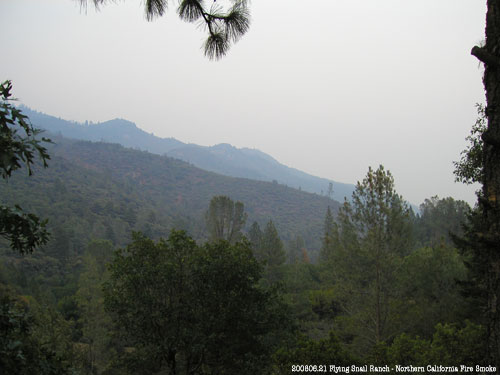
The above photo is my latest excuse for not working on the seismic shed and represents what some of the smoke from all Northern California fires looks like here (much thicker when the wind stops) and due to health problems, I have to remain inside until the smoke clears.
(200807.08)
No ARPSN progress due to smoke from Northern California fires. (fwiw) The smoke leaves a very fine ash on everything and messes up our county record of having the cleanest air in any California county.
If you would like to see a current Google Map of the fires in our area Click Here.
D700A Report - Besides the small amount of unauthorized packet transmission, I have noticed 3 cases where the power on the D700A has changed 2 times to H (high power) and 1 time to M (medium power) by itself. (fwiw) Once set (back in March) the radio has not been touched; except, to restore original settings I made.
Finally, it was 105.7 f. in the computer room yesterday (the first vent from the air conditioner comes into the computer room and sucks in the smoke, so we had to turn it off.) which makes it difficult to do anything.
Unless something new occurs, this will be the last post here for a while, until the Shed is complete.
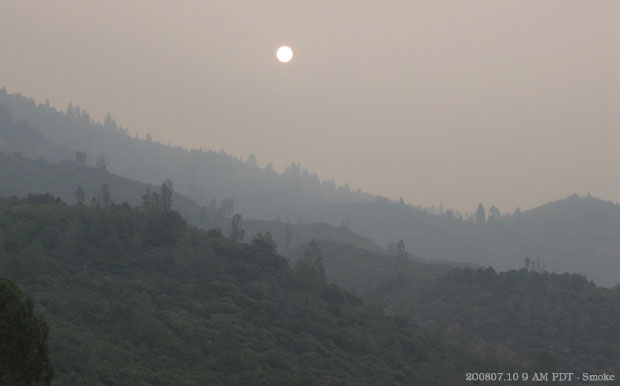
(200808.06)
The smoke cleared last week, most of my chores are caught up, and I started working on the Seismic Shed this morning, again.
(200808.20)
Continuing from above, I managed to tie the new foundation together with rebar and wire and set up for the concrete pour, which I had scheduled for the next day.
On the 7th of August smoke returned; this time from the Trinity fire up North, and for the next week the smoke remained, causing me to be 'house bound' again, without air conditioning, in the 100+ degree computer room.
By August 18th the smoke had cleared and I quickly caught up on backlogged chores, with hopes of finishing the foundation by Tuesday afternoon.
Tuesday morning (cyber) work took longer than usual and I was getting 'close to being done' by about 2:55 PM. Just as I was about to allow the ARPSN wx/seismic machine to upload new data, a BSOD appeared on its screen and died.
As stated before, I am one of those folks who believe, "If it's not broken, don't fix it," and once something is working, I leave it alone. In other words, I have not touched anything since starting ARPSN and the only thing different that happened before the BSOD was, a Microsoft security update, which caused a reboot of the machine. Shortly after the reboot, it died.
The next part comes from an article I wrote for my main page and placed here as part of ARPSN development history.
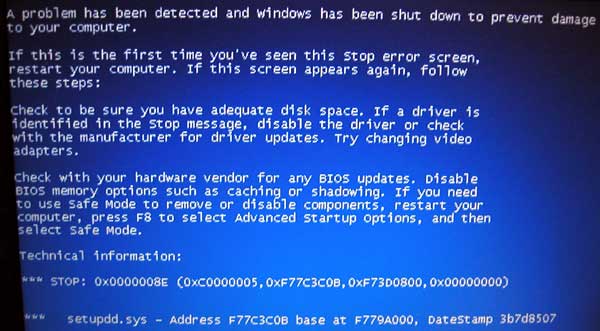
dBummerzs
- Part One: Expensive Paper Weights
Could Be Titled: Computer Corporatists
Fleecing Flock
Ok, so I know I should not attempt to write when I am angry, but WTF, Nobody cares more about ME than computer corporatists.
Yesterday (200808.18), a little after 3 PM, my Hewlett Packard/Compaq NC6000 Notebook displayed a BSOD (Blue Screen of Death) and died.
This is the machine that controls my weather station and seismic sensors for ARPSN.
Normally I would not get so angry, but there are added circumstances which fan this fire, starting with this quote from a thread on a HP Forum:
nc6000 no startup
I have an NC6000 which without warning will not start up. The power light comes on briefly, then the battery light comes on, fan starts, shuts off and nothing else.
Any help would be appreciated thanks.
There are many great comments and I found this one 'most interesting':
Why did the no-boot problem with the nc6000 suddenly arise at the end of July of this year? A search of these forums shows no similar problems prior to the start of this thread on July 28.
Odd, but possibly a clue...
Past vs. Present
I have been fixing, "My computer has turned into a paper weight," problems since IMSAI, and am considered extremely good at what I do.
All of my old machines; including two very early S-100 systems work fine today, along with my early Osborne and Compaq CP/M based portables (-; , that are the size of a small suitcase.
The best running machines are my Dec (Digital Equipment Corporation) Alpha and SGI machines; both of which, run Unix based systems.
About ten (10) years ago I started to notice a reduced user life of electronics and began to take notes.
At this point I am convinced manufacturers are designing electronics to last five (5) years or less, and here is my opinion on how that number came up. Usually computer products (the ones I shop for) have a two year warranty.. and, one can buy an 'extended contract' (good idea for laptops/notebooks) that usually adds another three (3) years, for a total of five (5). I have seen other electronic products, with shorter warranty periods, die within months after the end of a warranty.
My last three (3) PC purchases (Compaq/Hewlett Packard/Alienware) within the past 10 years, failed prematurely, none of them work now, all of them died with BSOD... and (to me) that is a lot of wasted money and high blood pressure.
Currently I use Apple products because my favorite companies (DEC and SGI) are no longer in business. I do have a long page which explains an interesting story involving Intel, Microsoft, and DEC titled, "How the Boyz in the Back Room Got Rid of Digital Equipment Corporation", if one is into computer history with source.
Point?
I am hesitant to spend any more money on electronic products until quality is restored. The only way I will be able to finish ARPSN is by apparently buying another Notebook and feel this would be like throwing 'good money on to bad money, already spent'. It also appears problems are showing up everywhere in electronics land.
For example, my main high frequency radio has been broken for nine (9) years (died two weeks beyond warranty) and I have been trying to find a competent replacement, with no luck, and could list many links of complaints about current amateur radio manufactures. (otoh) My real old (emergency) Atlas 210X HF radio and Swan 45 HF antenna (despite mild drift) still works like a champ.
One more thing...
I still do animation, video editing, music, currently use an old Mac dual 500 G4, and at one time had a large render farm running ten (10) tower machines, plus my wife's machines.
Our electric utility bill was quite high and since 2001 has become more expensive.
To date, I have eliminated the majority of towers for machines drawing 10 watts, or less (laptops and mini), and reduced the utility bill by forty-seven (47) percent. I am in the process of converting a majority of my electronics to alternative power.
A few years ago my G4 started to 'act up', so I started to look for a new tower and almost bought the 'latest, greatest', but had an odd gut feeling about the G5 being 'water cooled. I was about to click "Purchase" and am glad I did Not! If one is interested in reading why, check this out:
PowerMac
G5 Coolant Leaks
http://www.xlr8yourmac.com/systems/G5_coolant_leaks.html
A few years ago my wife offered to buy me a new MBP (MacBook Pro Laptop) for my birthday; allowing for more reduction in electric power by putting the G4 into storage, but I was not fond of MBP specs, at that time, and postponed the purchase.
Three and a half years went by, a MBP that fit my needs (A complete Movie/TV animation production package/etc. I could store in one small case) had became available, and I was about to hit Purchase again, when this popped up:
MacBook
Pro GPU/Video Failures
http://www.xlr8yourmac.com/feedback/MacBookPro_video_failure.html
The above threads also appear on Apple forums and like others, I am currently waiting to see if there will be a new MBP release that eliminates this problem.
Why Do I Still Work With These Products
I stopped using the Microsoft based PC years ago, but maintained one 'game machine' running XP Pro, which eventually got replaced with Play Station ;-) This also helped get over the 'no games for Mac' dilemma. (-;
ARPSN (sort of) required using Microsoft based machines because the majority of software for seismic and weather data required Windows.
My reason for saying 'sort of' is because, before retirement I was considered a 'top notch' developer and have a software development machine (SGI/IRIX) capable of producing excellent cross-platform.
During the 'old days' Unix admins were required to write their own device drivers, so writing controller programs (for me) is easy. I am also considered an 'above excellent tech' and . . the only problem is, statistically speaking, my life should be over in eight years, according to insurance companies, meaning; time has become a factor in 'getting things done'. In fact, last night I was considering 'turning it 'all' off and will explain why, but not today.
Notebook Is Toast
I just completed the last of my 'tricks' to get the notebook functioning and all diagnostic tests have failed.
As a 'last try', I attempted to install Fedora and it balked telling me, "This problem is serious, and the Install cannot continue."
Despite present feelings, I believe ARPSN may become useful one day and there are not that many who have the background to do it; that is, until it is simplified and explained. Plus, I am not about to let a piece of crap hardware with Windows software stand in my way! (-;;-) Yes, I'll shell out more (bad) money, replace the notebook, and say, in writing, this will be the last FNPOS WINPC for me, because Stupid can not be fixed!
Some References
Here is a brief description of corporatism from Wikipedia:
Corporatism is also used to describe a condition of corporate-dominated globalization. Points enumerated by users of the term in this sense include the prevalence of very large, multinational corporations that freely move operations around the world in response to corporate, rather than public, needs; the push by the corporate world to introduce legislation and treaties which would restrict the abilities of individual nations to restrict corporate activity; and similar measures to allow corporations to sue nations over "restrictive" policies, such as a nation's environmental regulations that would restrict corporate activities. [Continue Reading]
Here is an article written September 13, 2002 [Six (6) Years Ago]
What
is American Corporatism? By Robert Locke
FrontPageMagazine.com |
Friday, September 13, 2002
We are probably heading into some economic heavy weather which will spur needed debate on what's right and wrong with our economy. This will require our being clear about what kind of economy we really have. I have mentioned before that we increasingly live not in a capitalist society but in a corporatist one, and I would like to flesh out this notion.
What is corporatism? [Continue Reading] Me personally, I usually refer to THEM as the "Profits Not People Crowd" (YMMV).
It Appears I Am Not the Only One Feeling This!
Hams
and Trust in Hamfest/eBay Dealings?
by Ray Swan (NV2A) on August
18, 2008
Has civility with one another gone the way of taking your hat off in a restaurant or not cursing in front of children?
I have purchased most of my equipment at Hamfest and from eBay. Of the last three transceivers I've purchased only one was accurately described. This has me wondering, do I have to start buying all my gear new as I have no way of knowing the used gear is any good if we can't trust the ham we are doing business with to be honest. Character has been described as what you do when know one is looking. Is that it, you don't know the guy at the Hamfest or on eBay so it's okay to sell defective equipment.
Don't give me the "buyers beware." We all know that and it doesn't hold water if you can't spend a few hours with the gear you are buying to test it out under every conceivable situation. We have to be able to trust each other in our business dealings.
Is it just me or have others noticed the unwritten rule of hams being fair with fellow hams taking the deep six for greed? It would be interesting to hear how you've been cheated but please, no call signs here. I'd also like to hear any social redeeming stories of guys who have gone out of their way to treat you right. Call signs might be nice for this one.
Ray NV2A - http://www.eham.net/articles/19853 - (imo) The comments are a good read, too
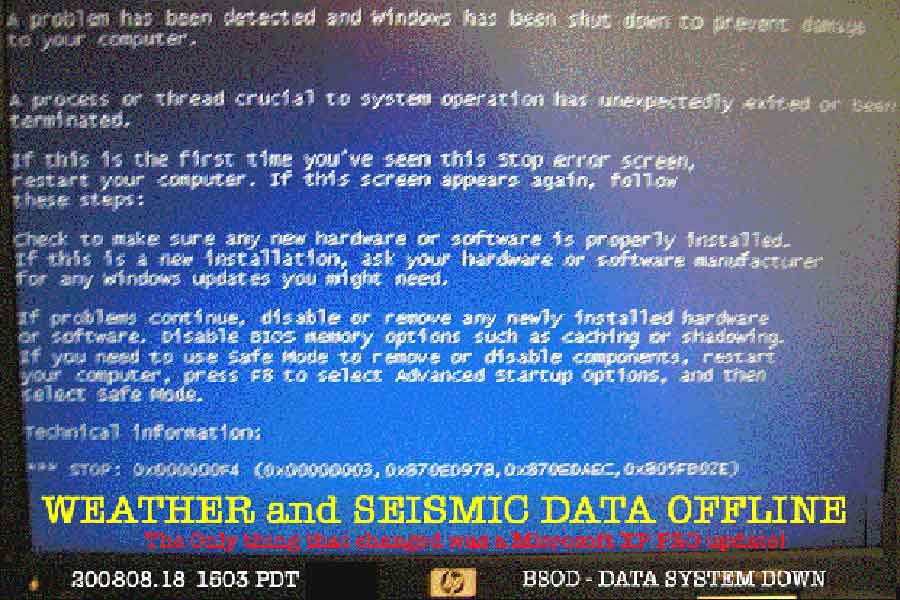
How's
the Weather?
SYSTEM DOWN - BSOD - WORKING ON RESTORE
Click above image for large picture. Top portion is local weather and bottom portion is recent seismic activity. UTC time noted on left. GPS date, with UTC and PDT time located lower left corner.
(200808.27)
The anger continues and I am at a point where the frustration is superceding understanding. The new laptop arrived a week later than anticipated, the notebook went 'belly-up', and RIP NC-6000!
(200809.14)
I lost a little over eight weeks of outside chores, during the Summer, due to Northern California fires and still have to get to the end of October before fire danger starts to fade.
Inside was miserable because we had to turn off air conditioning because it sucked smoke into the house. We used portable 'swamp coolers' to lower the temperature. The average day temperature of the (house) computer room during that time was 113.7 f. degrees; (otoh) I have another area where I can work and this is what has been happening.
Remember the (above) used laptop (controller for the sensors, WX, APRS) that died three days after warranty ;-) well, I was extremely brutal and fixed it, but have to explain something here.
One of my great pleasures in the past was building electronic stuff...and all was fine until the '80s, when multi-layered boards became more popular, and I could no longer, using my workbench magnifier, see components.
(tmalss/imo) Anything beyond two layers is next to impossible to repair and belongs in the junk box.
Having said that, I employed a few tricks to see if I could discover where the problem was.
[THE FOLLOWING IS NOT A RECOMMENDATION AND WILL DESTROY YOUR COMPUTER, DO NOT FOLLOW THESE INSTRUCTIONS, DO NOT DO THIS AT HOME - THIS IS NOT ADVICE - THIS IS AN EXPLAINATION OF MY EXPERIENCE !!!]
The first thing I did was remove the hard drive, put it in a 'moisture proof' bag, and stuck it in the freezer compartment of the refrigerator for about four (4) hours. [I have discovered this will sometimes let me know if it is the drive or (more than likely) a problem with the motherboard.] I then popped the drive back into the machine and got it to a point where I could, over the process of a week, install an iso of the original XP Pro w/SP2 image.
I then put the entire notebook (drive installed) in a larger moisture proof bag, let it sit in the freezer for another four (4) hours, and started 'blasting the drive' with an older, complete, version of 'Pro' I had for a broken machine in storage, until I got it to reformat the drive, and start to load the system. [Note: Due to confusing laws about reporting 'things', I am leaving out my notes as to the actual cause of 'this mess'.]
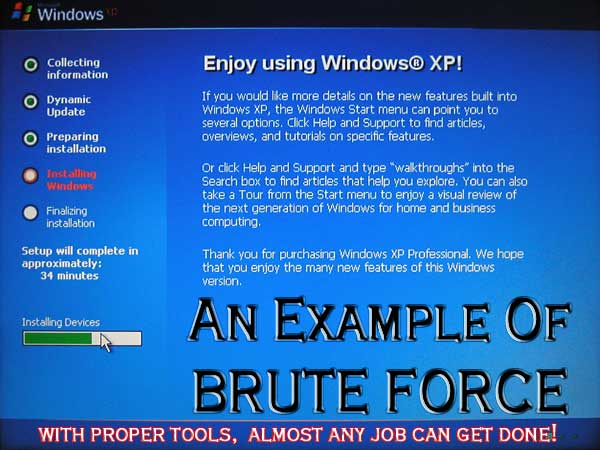
When the 'installer' reached the point of asking for the serial number, I removed the old XP Pro installer disk, replaced it with the disk containing the iso image, rebooted, and the original SP2 image installed perfectly.
Having reached this point, I decided to re-install XP Pro again, except, this time, I pre-figured the size of installs, and created two partitions; one for Fedora 6 (I have a set of disks, thanks Hank!) and one for XP Pro
I installed XP Pro first on drive C:, and then did all the updates (19 hours via dial-up).

If anything were to wipe out access to the XP Pro system, I wanted something that would allow me to monitor that, so I installed Fedora 6 (GNU Linux) and did 247 updates (48 hours via dial-up). [Note: I have ~BSD and GNU ~Linux (64 bit) developer experience and was on the OS-2 (IBM) and OS X (Apple) developer teams. (For example, I wrote the first C based controller for the Yaesu RS-232 interface, which was announced on an early Amateur Radio list, before the Internet, and originally written on a Sun 360-C, that was in our basement at Toad Hall.)
Beta Test FRG-9600 Source Code Fragment
Jun 13 1989, 7:46
pm
Curtis Spangler
Source: rec.ham-radio
I have a source code fragment for
controlling the YAESU FRG-9600 scanner. This fragment is translated from
the Basic programme
listed in the FRG-9600 Service Manual to the C programming language
using Turbo C version 1.5. It may work on other YAESU (C.A.T.) devices
with modification (not tested).
If you are interested in 'beta testing' this code please send email.
--
Curtis Spangler {sun,pacbell,uunet,pyramid,amdahl}!hoptoad!cas cas@toad.com
N6ECT P.O. Box 170031, San Francisco, California, 94117-0031
"Without love in the dream, It will never come true." J. Garcia / R.
Hunter]
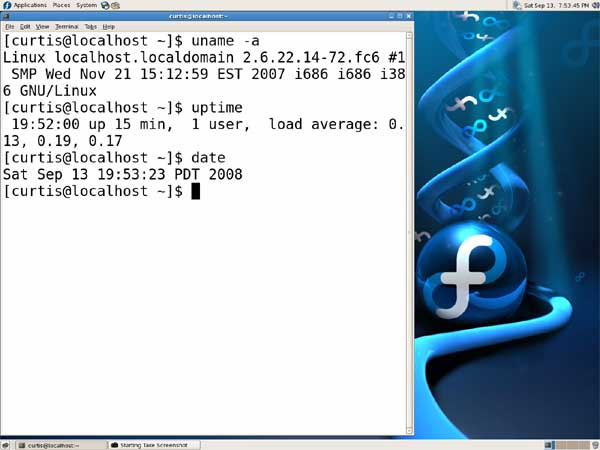
[Note: For some ??? unknown reason (I have no intention of exploring, other than providing a fix.) both Fedora and XP would no longer (on the NC-6000) do 'reverse look-up'; meaning, I could connect to a Website using an IP number but NOT via domain and extension (flyingsnail.com, etc.) using my original DNS numbers.
In order to fix this, on both operating systems, I had to change DNS lookup from my host DNS numbers to ones provided by Open DNS (primary and secondary): 208.67.222.222 and 208.67.220.220 - and Internet access was restored.]
The next thing I did was hook up an old Kantronics PacketCommunicator 3 TNC to the notebook and installed UI-View16 on the XP side.

I downloaded the source to XASTIR, compiled it on the Fedora side and in a few months will compile it for Mac OS X.
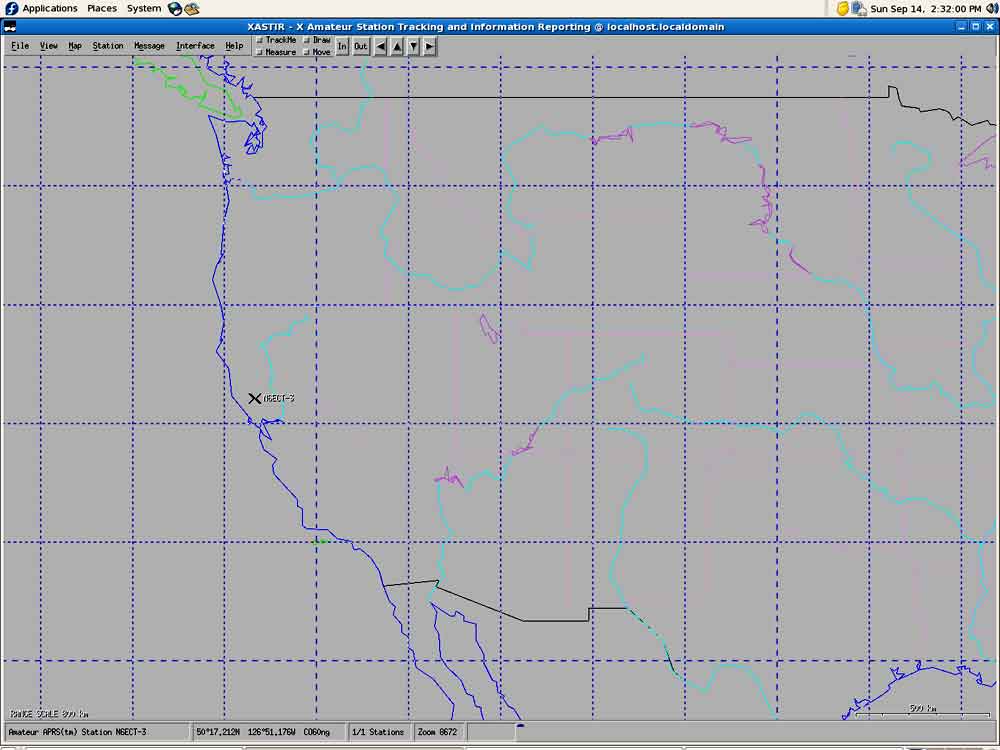
Click for large image - [Note:
Screenshot is a 'stock' compiled install of Xastir on Fedora 6.
More later.]
I am about at a place where I can return to the completion of the Seismic Shed and (fwiw) all sensors continue to work without problem (The VolksMeter is truly amazing!).
You have probably noticed there are seismic and weather updates happening again and they are running on a new HP laptop 'controller' with an "Intel Centrino" processor, under Windows Vista (Office). I'll comment on Vista later, but it is not good.
Finally, time for the 'mini-lecture' again (-; The above work will allow me to explore a less expensive approach to ARPSN.
What I am using now (the model works for me) may appear expensive at the moment, but will be reduced (in cost) as time moves forward.
(200809.18)
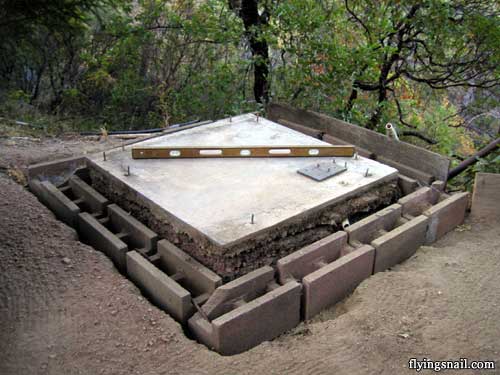
Building removed from slab. Rain predicted Friday (early but welcome).
(200809.22)
Slow but sure are the words for today... and as usual my anal kicked in at the last moment and extended the job, but in a good way.
It took me a day to disassemble the shed and move the wood to the workshop. (fwiw) Up to this point, everything from the old shed has been recycled into the new shed, all other material was at hand (left-over from other jobs), and with exception to concrete and sand, no extra expenses have occurred. (-; knock on wood ;-)
Originally, I had everything mapped out as a '1-2-3 process' and had hoped to have the 'base' finished by Monday morning, but I forgot to add a drain.
If one looks at the above picture, the corners (towards the right) seem to drop off the edge, and the ground leading up to the left side of the picture, slopes down.
I removed everything, dug the trench deeper (at a down slope angle), installed a wood positioning frame, surrounded the bottom of the foundation with pebbles, added a layer of fine red lava rock (about eight inches), realigned (squared and leveled) the concrete blocks, rebar'd it, installed the metal mounting frame (that will be sealed in cement) with bolts inserted, put a layer of sand between the slab and blocks, and am letting everything settle for the night, before I 'pour' (cement) tomorrow.
I learned something new, based on my age... if I work for an hour and rest an hour, I make decent progress; however, that does not eliminate 'tired and sore'. (-; Working on the downward slopes was a PITA.
As far as shed construction, I have decided to approach that in stages and here is what I have in mind.
First stage, (without insulation) reinstall ARPSN-1 (L15Bs) compare old charts with new charts, note ??? improvements.
Second stage, add internal insulation, install Flying Snail/Cobb Mountain PSN (VolksMeter) compare old charts with new charts, note ??? improvements.
Third stage, slowly cover shed with ten pound sand bags (to remove helicopter noise) and compare old charts with new charts, note ??? improvements. Anything beyond that (notable noise), will be filtered out.
(fwiw) The white pipe (above slab at top right of (above) picture) goes to a large holding tank (along with others) that is used for a 'back-up water supply' (primarily) during "fire watch" and will be connected to a gutter system on the shed.
Winter is coming and I am almost four months behind, on my original schedule. == Just goes to show, One never knows (-;
(200809.26)
1100 pdt - New Shed foundation poured and setting. Monday and Tuesday were occupied by jury duty and I slightly changed the shed layout (anal trip, but better plan). I have already started shed framework and would like to be finished and online sometime Monday with ARPSN-1 (L15Bs)... and maybe the VolksMeter.
(200809.28)
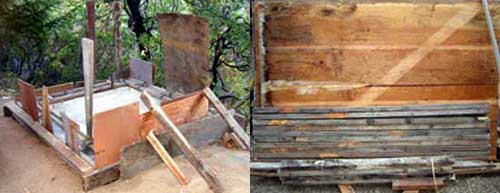
I am leaving the concrete set for an extra day, or two, and intend to finish the framework for installation tomorrow.
(200810.06)
Short version: We had a rogue rain storm, ARPSN-1 back online for testing purposes, and I am tired. (-;
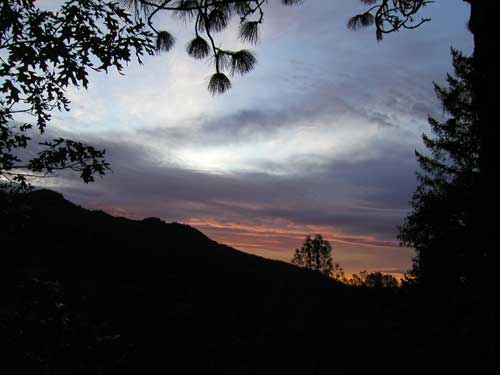
The new shed is at a point where I can start testing for wind noise, etc. and heliplots will be uploaded.
The shed has not been sealed and there is no insulation.
Seismic data will be ON/OFF line until the shed is ready for the VolksMeter.
This is part of "new shed test one" with L15Bs - pictures later.
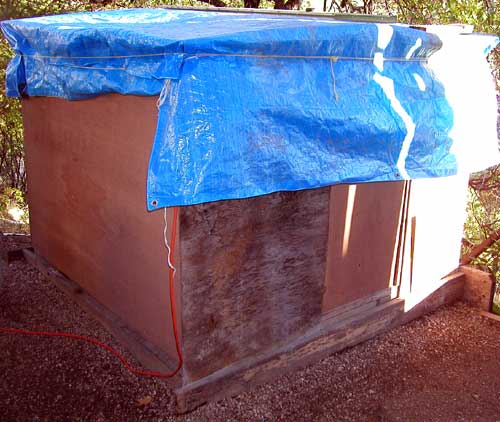
As usual, I kept making 'on-the-fly' adjustments during construction, which increased the time it took to get done, and used about ninety-eight percent (98%) of the old shed to rebuild the new shed. (fwiw) The original shed was built by a carpenter and was nailed together. All nails have been removed and the entire shed is screwed and bolted together (It can be disassembled and moved; except for the slab and new foundation).
On the day we had the 'rogue rain storm' (2.61 inches) I was trying to finish the roof and discovered the boards I had set aside, were too short and also needed one more piece of siding. These items should be delivered this afternoon and installed by tonight.
I managed to create a temporary roof and double tarp it (above picture) before the storm hit. ;-) I am proud to say the new seismic shed survived our first rain of the season.
I hooked up ARPSN-1 (L15B sensors) and sealed the remaining shed with odd pieces of lumber.
Heliplots are very much improved and it appears, in the end, this shed may work.
Heliplots located here: http://www.flyingsnail.com/seismic.html
The wind only reached 9 MPH last night and there was no visible wind noise on the heliplots. I have not heard a helicopter yet, but will continue to listen. It appears the (what I call) "Geysers Hum" noise is now gone from the E/W channel.
200810.06 - 19:50 - The wood arrived at 17:56 and I spent the day cleaning up.
Seismic data will be off-line tomorrow while I install the roof and remaining front siding.
I am leaving the concrete set for an extra day, or two, and intend to finish the framework for installation tomorrow.
200810.09
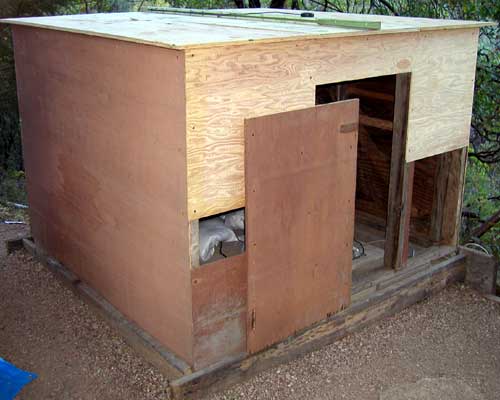
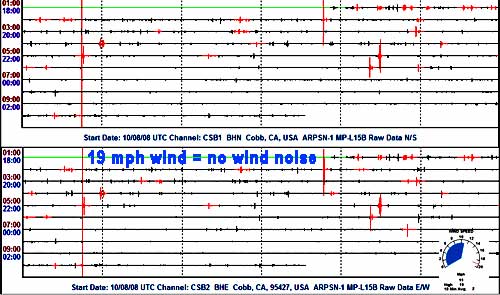
Before
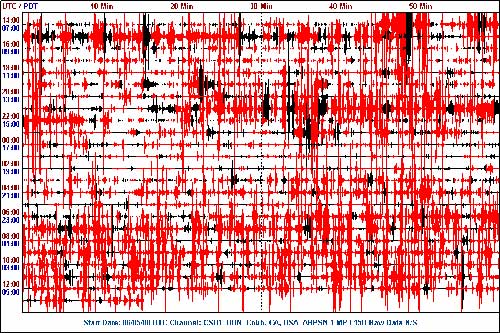
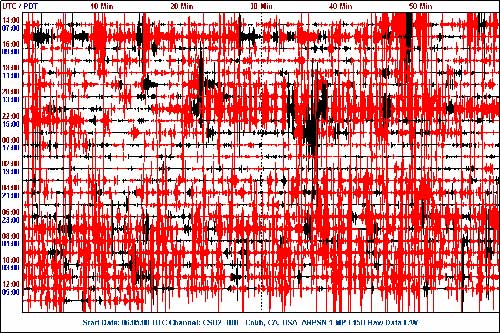
After
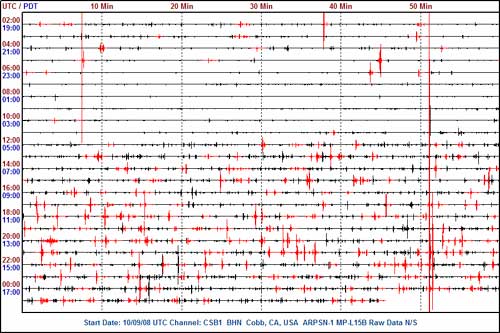
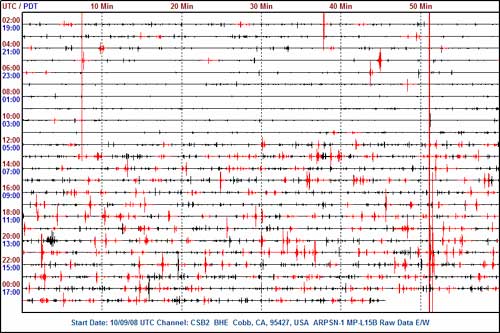
200810.20 - Seismic Shed Re-Construction
200810.20 - 0616 PDT - Completed cable run from computer room to seismic shed for the VolksMeter and started on insulation, which is taking longer than I anticipated (again)... and plugging shed nail holes. To be continued with pictures later.
This weekend I am attempting to finish installing insulation, plus a few other things in the seismic shed, so seismic data will be off-line. If this goal is achieved, the VolksMeter should be On-line by Monday and I can pick up where I left off, before the Northern California fires this past summer.
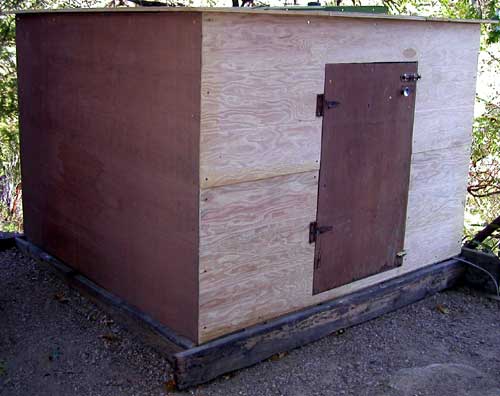
Yesterday, I finished rough carpentry on the seismic shed rebuild and have two L15B sensors running.
I moved the L15B sensors back to SPS (samples per second) 100 and changed GIF filtering from NONE to Low-Pass Filter 2 Hz - 2 Poles, on both channels, in order to eliminate "road noise", per Larry's advice.
The first preliminary tests were done without insulation (in the shed) and, up until yesterday, had open areas allowing for 'heavy drafts' to pass through openings.
The heliplots on this page reflect before and after pictures of wind noise elimination and now, with the shed mostly sealed, new heliplots will show what the result will be.
On the 'to-do list' for next week, weather permitting, is filling all old nail holes with wood putty, installing insulation, and painting a coat of waterproof primer on the shed. After these things are completed I will move the VolksMeter back into the shed and today, will attempt to install new RS-232 cable for it. (fwiw) Down the road I intend to try a RS-232 transmitter/receiver to see if I can eliminate long runs of cable.
(btw) I noticed helicopter noise had been reduced to half the size of original (old shed) noise shown on heliplots and look forward to seeing if insulation reduces this noise some more.
(fwiw) One of the reasons why the shed took so long to rebuild was because I replaced all nails with screws and bolts. The new shed can be taken apart and moved.
Finally, when it happens, it will happen; meaning, ;-) I have an interesting art design for the shed (-; but may wait until next spring to add it.
[UPDATED - New Information == Note: '6 Hz' '4 Pole' Low-pass filters have been added to ARPSN-1 (L15B sensors), which eliminate noise on heliplots. I changed these from 2 Hz 2 Poles to make heliplots more interesting
Trace lines will remain flat until a local >= 1.0 magnitude earthquake occurs. Flat red traces represent 1.0 magnitude or less.

From now on heliplots will appear different. The above image (at bottom) is an older example of a new heliplot showing a single red vertical spike.
The below WinSDR image (normally located at bottom of weather pictures) corresponds with above heliplot, showing original 2.3 magnitude data trace received here, which is larger than the heliplot image. [Green traces represent OFF-LINE.]
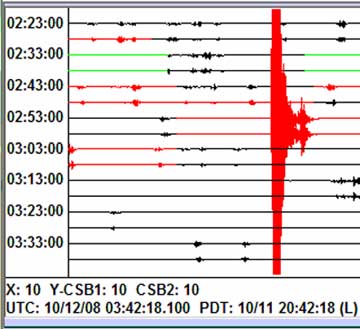
The vertical spike represents a 2.3 Magnitude earthquake at "The Geysers" and appears on this USGS list:
http://quake.usgs.gov/recenteqs/Quakes/quakes0_fault.htm
on this map:
http://quake.usgs.gov/recenteqs/FaultMaps/123-39.htm
USA list:
http://earthquake.usgs.gov/eqcenter/recenteqsus/Quakes/quakes_all.php
World list:
http://earthquake.usgs.gov/eqcenter/recenteqsww/Quakes/quakes_all.php
ARPSN-1 Alerts are intended to begin at >= 5.0 magnitude in our (as of now, undefined) local area and the 'yet to be installed' sensors will cover teleseismic and LFE (low-frequency earthquake) events.
200810.22
The insulation has been completed for a second stage of tests and later today I will start re-installing seismic sensors; starting with ARPSN-1 (L15B sensors), and if there is enough time, install the VolksMeter sensors.
A full, consecutive, progress log is available for viewing here: Progress Log: Complete
Seismic Shed: Re-Construction
200810.25
First things first, the seismic shed is set up for second stage testing and the VolksMeter II is going through a thirty (30) day fine tuning process.
If one looks at current heliplots, one will notice 'the difference', and eventually plots will begin to appear as those shown in previous progress logs.
The seismic shed took longer (as usual) than expected because of a constant "what if I try this" attitude. Fortunately, I had drawn out a (root) plan that helped me remember the 'original goal' and managed to 'fall back' on it, when frustration began to mount.
I am at a point of deciding whether it is worth it to create an inner false wall in the shed and spray it (full) with acoustic foam... or covering the shed with sand bags, which is part of the 3rd stage of testing, but this may be 'overkill'. For now, one test at a time... starting with a new calibration (sometime this weekend) of the VM II.
Some may have noticed I have not activated certain (software) features available (to me) and my reason for this is, software and related tasks are set aside for Winter work, which appears to be getting closer.
Some may have seen the following piece on my main page, which is ARPSN and Flying Snail Public Seismic Network related, and reproduced here:
Immaculate Connection

Late yesterday afternoon (200810.23), my hybrid LAN router started to fail at the same time I was completing the first phase of fine tuning on the VolksMeter II sensors, in the seismic shed. Seismic Shed Re-Construction - Complete Progress Log
Shutting the router and modem off for a while, letting it cool down, and turning it on, allowed for about 15 minutes of connection time, before it would freeze again, and I used this method to upload new seismic data files. Heliplots
Fine tuning is something that takes longer than necessary because of an over anal approach to accomplishment, which is not necessarily a good thing, all the time.
Before going to bed, I turned the modem and router off and pulled the ethernet cable out of the Vista, HP laptop (I have autoupdates turned on, but will not allow Vista to connect to the Internet without me being present, for specific reasons.... and yes I could turn it off, but...)
When
I got up this morning, after experiencing a 2.9M shaker:
(http://quake.usgs.gov/recenteqs/Quakes/nc51210050.htm ),
I walked into the computer room and noticed the Vista box had my login prompt on the screen!
I needed that 2.9M quake to help me tune the VolksMeter gif display, so I logged in and Vista told me it had downloaded new software, installed it, and rebooted (see above image).
I have autoupdates set to trigger at 3 AM, there was NO WAY this machine could have reached the Internet (ethernet cable removed), and there was absolutely no logical way this could have happened... unless it was the first known case of Immaculate Connection?
Because I rise early, the first hour of chores are usually on automatic, so I did not save all the proof that would support my claim, but (imo) I saved enough.
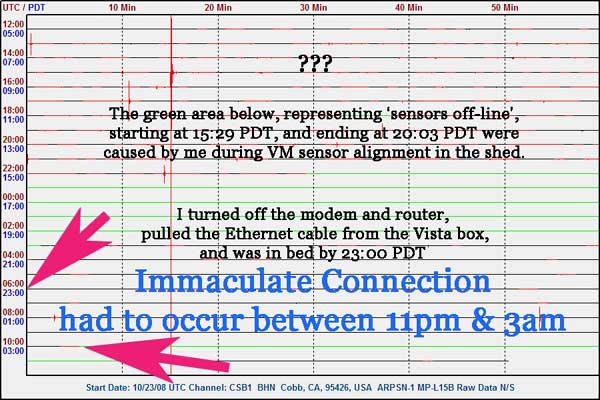
I have no intention of wasting any time trying to figure out how this happened, because it is too weird; even for me! (-;
Above and beyond minimal personal frustration, I have been having a lot of fun doing this project. More later.
200810.29
Added Noise page - Updated ARPSN to reflect active PSN stations (from Larry's Redwood City Public Seismic Network page).
Changed VolksMeter from ADCB: 16 SPS: 80 to ADCB: 24 SPS: 10
As one may have noticed, the VolksMeter II is publicly on-line and running through a series of tests, starting with setting various ADC bits and SPS (samples per second).
The VolksMeter is currently running ADCB: 16 - SPS: 80 (I started at ADCB: 24 - SPS:10, then ADCB: 22 - SPS: 10, then ADCB: 20 - SPS: 10). The final setting will be in the area of ADCB: 24 or 22 and SPS: 10.
My personal experience is, the VolksMeter needs about a month (at a new location) before it starts to settle down, which is when it needs a final re-calibration.
One may have also seen the large red tracer plots, from a few days ago, that were a result of accidentally bumping the L15B sensors while adjusting the VolksMeter... What can I say, other than I am tall and the shed is small (-;
Allegedly, there is a winter storm headed here this coming weekend and preparation for Winter is a few chores shy of being done.
200811.23
Short note, for now. Everything is functioning and I am between multiple jobs, while upgrading to a newer machine. If there is time available tomorrow, I will attempt to do a test run of the VolksMeter at SPS 40 in order to determine the level of local noise vs. sensor. I ran the VM for about six months at SPS 25 without problems in a different environment and used that setting during the first week of the current stage of tests with success.
A full, consecutive, progress log is available for viewing here: Progress Log: Complete
Seismic Shed: Re-Construction
Noise page
200811.24
The VolksMeter sensors have been moved to ADCB 24 SPS 40 (200811.23 - 15:15 PST).
According to the VolksMeter engineer, this is the maximum I can run these sensors ;-) until I build a more noise resistant concrete bunker seismic shed (-; however, I am pleased at the current level of noise reduction.
The VolksMeter heliplot chart will take a little while to adjust as I tinker with fine adjustments. I will attempt to post heliplots before I go to bed tonight.
Moving these sensors to SPS 40 will increase teleseismic event detection and I will attempt to provide an example later... when a good event appears.
Another thing I need to do, if weather permits, is one more complete major sensor alignment before Winter sets in.
200811.29
The VolksMeter sensors have been moved from ADCB 24 SPS 40 to ADCB 24 SPS 25 (200811.29 - 15:21 PST) because of 20+ MPH winds that create noise on my 'final displays'. Running the VolksMeter at SPS 25 gives me better display with less noise, which led to a new thought.
A friend recently completed building his incredible straw bail house and it is my intention to contact him regarding placing straw bails around and over the seismic shed as a possible step in noise reduction.
200812.10
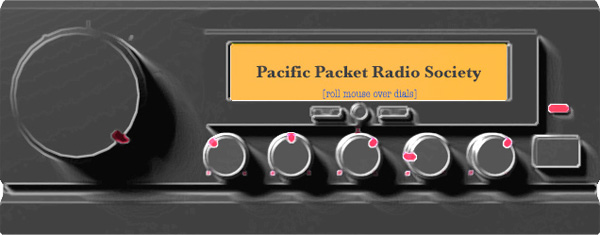
Pacific Packet Radio Society gateway | history | photos | papers | links | packet
audio | video
December 10, 1980
28th Anniversary of Historic KA6M Digital Packet Radio Repeater
First United States Wireless Data Communications
August 11th, 1981
Dear Packet Radio Enthusiast,
Thanks very much for the letter of inquiry which you sent me. The response I've received to the initial publicity about the packet repeater has been very enthusiastic, and I have been deluged with requests from hams, both locally and from various points around the country, for more information about the repeater, for schematics, for listings, specifications, modems, proms, SDLC chips, Vancouver boards, and for talks at clubs. Needless to say, all this activity, plus continuing development on the packet hardware and software has kept me very busy, and I apologize for the long delay in responding to your letter. Let me bring you up to date on what has happened, or is happening, since the initial announcement of the repeater, which went on the air in December of 1980.
In the early months of this year, the packet repeater was operating out of my residence, and was still an experimental machine. Since then, we have installed a couple of upgrades to the control software, we have used a better CPU card, increased the power level, moved the repeater to 700 feet elevation, and integrated its operation to be 100% compatible with the protocol used by the Vancouver Digital Communications Group (VADCG). The repeater has changed from being a laboratory curiosity to a major Bay Area repeater heard from Berkeley to south San Jose, and the user community has grown from a couple of stations to a network of some 30 users. The packet system here now has a mailbox on-line 24 hours a day, several on-line personal computers, and network links (courtesy of a commercial packet network) to the other active packet radio centers in Vancouver and Ottawa. We have also just installed an HF port on 20 Meters, and are beginning some experiments aimed at establishing connection with AMRAD in Washington and with equipment located at W1AW.
Most of the original packet radio experiments were done in Canada (in part due to the Canadians' pioneering communications spirit, and in part due to less restrictive regulations up there), and three main centers were at work: Montreal, Ottawa and Vancouver. The technology employed by each of these groups differed, and each approach has its own merits. My thinking and ideas very closely paralleled the work started by Doug Lockhart, VE7APU, and I can best report on what is happening with groups which have adopted HDLC (High-level Data Link Control) framing as the basis of their protocol. The HDLC/ SDLC frame is a new, universally accepted standard in the data communications industry, and Doug and I feel it offers a good starting point on which to build a packet radio network. As it turns out, groups in Washington D.C., Los Angeles, El Paso, Denver, Sacramento, and Hamilton have also taken up this technology, and it is likely that we already have a sufficient number of people using this technique that it will become the defacto standard in the amateur radio community.
It would be impossible for me to completely describe the protocol and equipment being used in this letter, so I will briefly cover some of the topics and give you some pointers on where to find additional information. As you might guess, this is a new area for amateur radio, and tutorial material and handbooks simply do not yet exist. Many issues and problems remain to be discussed, and there is opportunity to make substantial contributions to the state of the art. [Snip] [Continue Reading]
Thanks again for your interest. See you on the net.
Best regards,
Hank Magnuski, KA6M
More Papers and History: http://www.pprs.org/pprspapers.html
Magnitude 6.8 - KERMADEC ISLANDS REGION
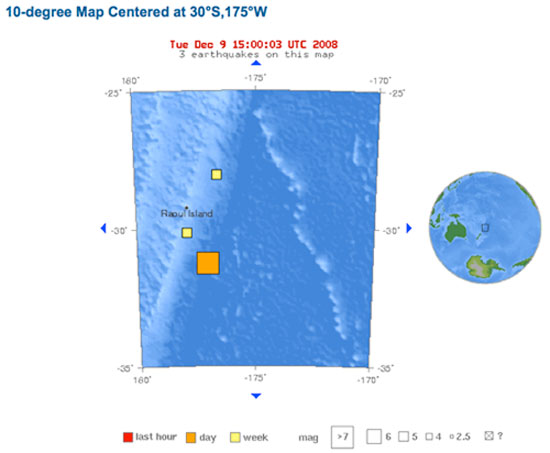
Tuesday, December 09, 2008 at 06:24:02 UTC
Tuesday, December 09, 2008 at 06:24:02 PM at epicenter
horizontal +/- 7.4 km (4.6 miles); depth fixed by location program
NST=154, Nph=154, Dmin=218.2 km, Rmss=1.09 sec, Gp= 50°,
M-type=regional moment magnitude (Mw), Version=7
USGS NEIC (WDCS-D) - us2008ajap
http://earthquake.usgs.gov/eqcenter/recenteqsww/Quakes/us2008ajap.php
Recorded by ARPSN/Flying Snail Seismic Sensors

Great Circle Distance 2765 Miles from ARPSN
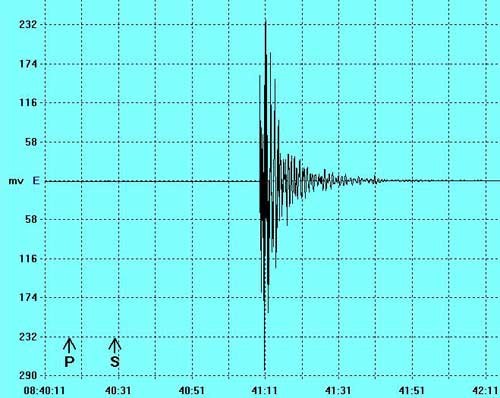
VolksMeter Sensor E/W Accelerated
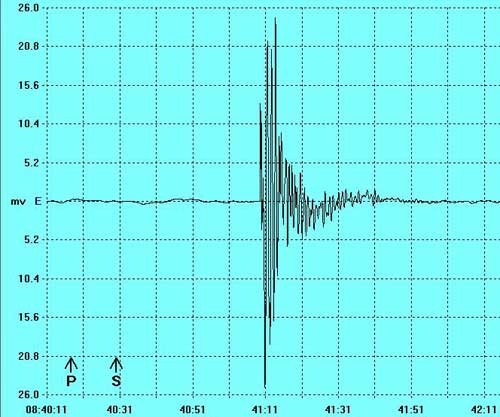
VolksMeter Sensor E/W Velocity
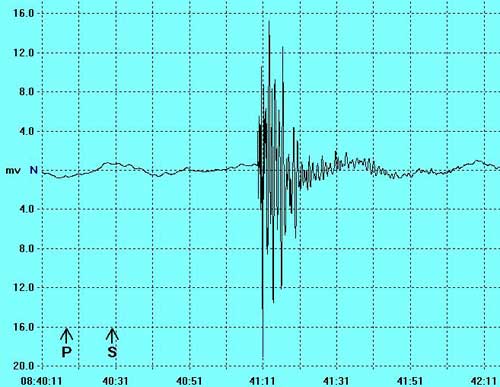
VolksMeter Sensor N/S Velocity
Magnitude 7.2 KEPULAUAN TALAUD, INDONESIA
recorded by ARPSN
Click to View Complete Page of Below Presentation

Distance
(degrees) 104.16 Travel Time (min:secs) 13:59.7 Arrival Time UTC 17:48:51.7 Pdiff
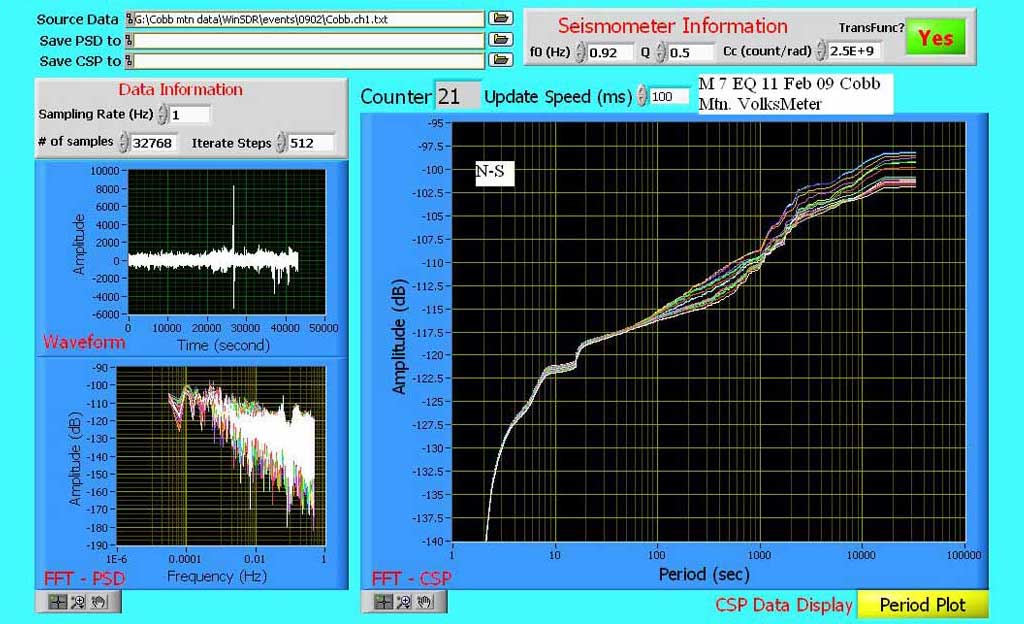
Cobb [Mountain], CA - N/S Magnitude 7.2 Recorded by ARPSN - Click for large image
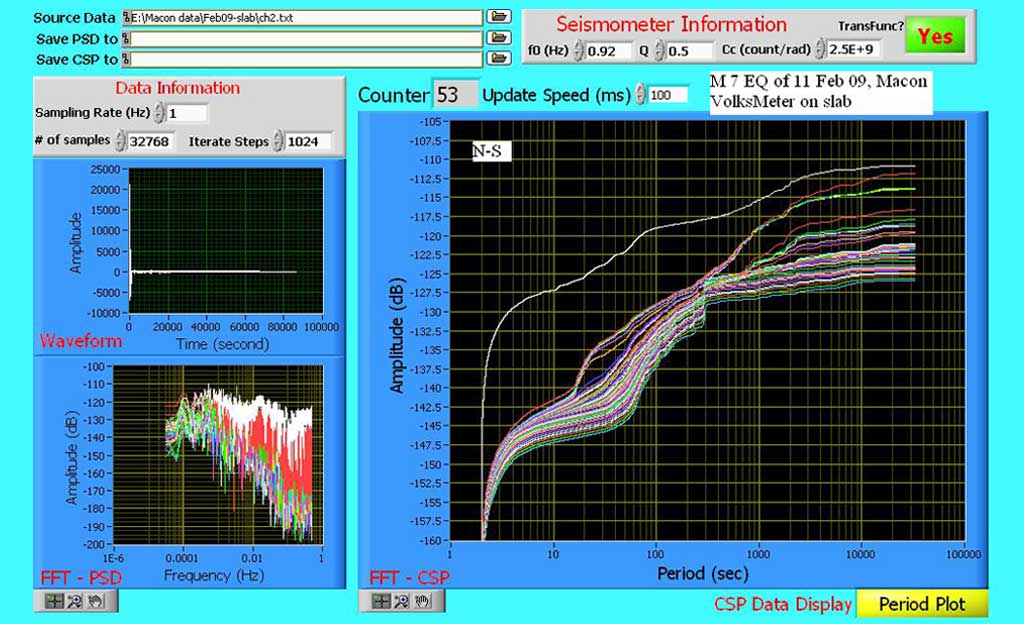
Macon, GA - Slab - N/S - Magnitude 7.2 - Click for large image
Click to View Complete Page of Above Presentation
Added new page:
2009 February [Redwood City, CA - PSN - Animation]
VolksMeter FFT-CSP Display - Magnitude 7.2 KEPULAUAN TALAUD, INDONESIA
http://flyingsnail.com/AmateurRadio/Indonesia7-2-fft-csp.html
200902.11
Added new pages:
2009 February [Macon, GA - SLAB - Animation]
2009 February [Macon, GA - PIER - Animation]
2009 February [Comparison - Cobb, Macon Slab & Pier, Redwood City - Animation]
200902.09
Added new pages:
Cobb Mountain FFT-CSP Animation:
2009 January [With Channel One earthquake audio]
200902.07
Added new page:
VolksMeter FFT-CSP
A New Look at an Old Tool:
the Cumulative Spectral Power of Fast-Fourier Transform Analysis
Sheng-Chiang Lee and Randall D. Peters
Physics Department, Mercer University, Macon, GA 31207
http://www.flyingsnail.com/AmateurRadio/VolksMeter-FFT-CSP.html
This page includes FFT-CSP Graphics and Animation
200902.03
Added two new pages:
VolksMeter and L15B SDR Settings [L15B images soon]
http://www.flyingsnail.com/AmateurRadio/VM-SDR.html
VolksMeter SDR Seisdata
http://www.flyingsnail.com/AmateurRadio/seisdata.html
200901.27
On 200901.27, 0000 UTC, the VolksMeter sensors were set: SPS: 10 and some settings were changed. I will explain later.
Soon, a 'What's Your Settings' page will appear as a WinSDR visual aid; starting with the VolksMeter. The test page is complete.
I am pleased with the last sensor 'tune-up' and with the results.
During Spring I anticipate implementing some 'acoustic dampening' wall board (sheet rock), if I can get a small amount delivered and have been discussing using a straw bail enclosure for surrounding the existing seismic shed with a person who recently completed his straw bail house and stated how quiet inside had become.
200901.17
Recently we had a decent shake which bumped a few things around, knocked a few things down, and moved one of the seismic sensors a little over an inch from North center.
I spent the past eight hours realigning everything and was pleased to see that the interior of the seismic shed was in excellent shape with no traces of any sort of critter; including spiders, or signs of leakage visible.
We've already gone through several snow storms and I was wondering/concerned how my shed construction turned out. == I'm Happy and it was worth the extra work!
Speaking of weather, and I am going to repeat myself again, one of the reasons this location was selected was, it provided six months outside work and six months inside work.
About eight years ago the weather changed... as our Winters became warmer and we started getting less precipitation.
For example, normally, at this time of year we are 'locked in' (due to weather), have about sixty inches of rain (our average was between 100 and 150 inches), and I would be working on ARPSN and various computer projects, etc. until Spring.
Currently, our total precipitation is 16.89 inches, for the past week and our temperature has been mid 70f degrees, when it is supposed to be Winter. Also, for the 8th year in a row it appears we will, again, lose our fruit crop.
Our Winter spring, which usually sends a raging river through the North end of the property, is barely a trickle (We have 4 other water sources and are not concerned about this.) and we have had continual wind; some gusting up to 50 MPH, which has, again, dried out everything, re-establishing a fire hazard. In turn, I am having to work outside and am getting tired of this cycle.
As soon as Winter returns, I'll get back into this project.
200812.29
Just a short note to announce work on ARPSN is still in process and as Winter settles in, I will be able to take care of some paper work and other 'stuff' that will enable this project to move forward.
200903.05
New page: VolksMeter CSP Averages
Here are two PSN stations run by Amateur Radio operators providing excellent seismic information and pictures:
John Cole's (W5AUH) Public Seismic Network Station -
Pearland, Texas, USA
http://pages.prodigy.net/fxc/JC.html
Frank Cooper's (W5VID) Public Seismic Network Station -
Friendswood, Texas, USA
http://pages.prodigy.net/fxc/
Updated page location for Alan L. Jones, where the following programs reside:
Seismic/Eruption: A program for the visualization of seismicity and volcanic activity in space and time.
Seismic Waves: A program for the visualization of wave propagation
AmaSeis: A program to obtain seismographs from the AS-1 Amateur Seismometer
Eqlocate: An interactive program to locate earthquakes using P-wave arrivals
200902.18
The weather has, at least for the moment, turned to Winter, giving me a little free time and I am working on how to reduce entry cost of adding an Amateur Radio Public Seismic Network to one's station.
Getting Started:
The least expensive entry for the Amateur Radio Operator is FREE, providing one has a VHF/UHF radio or scanner that covers: 162.000-174.000, 216.000-220.000, and 406.100-420.000 Mhz.
Seismic data transmissions can be identified by the listener by their continuous tone. Ground movement modulates the signal which changes the tone. As the spring loaded mass moves in one direction the tone increases pitch, movement in the other direction decreases the pitch of the tone. The analog data produced can be displayed on the rotating drum seismographs that we see on the 11 o'clock news after an earthquake. During an "event", this analog data is digitized at a rate of 100 samples per second and saved in the data processing center for analysis.
VHF and UHF frequencies used to transmit the data are usually found in the US Government frequency allocations. Occasionally you may find telemetry on frequencies licensed to universities. Transmitter output power is typically less than 1 watt. Many sites provide reliable data with only 100 milliwatts of output power. The signal is transmitted by horizontally polarized beam antennas and may be relayed several times before it reaches a processing site. Emissions are narrow band FM.
Routine monitoring of the voice channels of the USGS does not produce a "hot bed" of excitement. Voice traffic is normally between technicians testing equipment or making transmitter adjustments. Some traffic concerns the daily checks which are performed on all data channels to insure signal integrity. However, following a significant earthquake, traffic can be heard concerning epicenter location, evidence of surface ruptures, placement of sensors, microwave path alignment, and communication between scientist and engineers in the field.
http://www.seismicnet.com/info/telemtry.txt
There are California Telemetry Frequencies listed on the above page and when I have spare time, I will post some sample audio of the USGS frequency tone.
I Can Hear A Tone, What's Next?
If a "continous tone" is discovered, and one has a PC, there is a free demo program, "Demo Version of Program is Now Available- Runs on Windows 95 through XP. Install it and start monitoring nearby seismic telemetry stations today."
GeoTool Seismic (PC) Telemetry
Monitor Computer Program
Monitor
Analog Telemetry Stations with Scanner
Rick - WA6JKH
Not just another seismograph program! It is a complete demodulator for monitoring tone modulated seismic telemetry stations! Using your scanner radio and the 16-bit sound card on your computer, GeoSeis is capable of 15 to 16 bit resolution with a good signal and quality receiver.
This exciting new computer program uses any good quality scanner radio to demodulate standard and non-standard telemetry frequencies. The sound card in your computer converts the telemetry tone to digital information. The program runs under Windows 98, and is anticipated to provide 12 to 16 bit data from the telemetry signal. We are truly excited about the breakthrough sound card programming technology provided by Silicon Pixels. The program not only yields excellent accuracy, but also true Digital Signal Processing noise reduction for those weak signals.
'GSP-Seis' is a new Seismic Telemetry Aquisition System for monitoring USGS seismic telemetry stations using audio from almost any scanner radio and antenna system. The program uses your computer's Sound Card as a 16-bit Analog-to-Digital converter. State of the art Digital Signal Processing (DSP) programming uses the processing power of your computer to pull weak signals out of the noise and provide usable data. Separates single tones from multi-tone systems such as those being used by the University of Washington at Mt. St. Helens. (Note that you must have a telemetry station within range of your monitoring point for the system to work. See below for information on how to find the location of seismic telemetry transmitters.)
Telemetry Transmitter Frequencies - http://www.geotool.com/TelmFreq.txt
Source: - http://www.geotool.com/geoseis.htm
I Have A Mac, Is There Anything For Me?
SeisMac 2.0

http://www.suitable.com/images/seismac2Screen.jpg
SeisMac is a Mac OS X application that turns your MacBook or MacBook Pro into a seismograph. It access your laptop's Sudden Motion Sensor in order to display real-time, three-axis acceleration graphs. Version 2.0's enhancements make SeisMac an even more valuable tool for classroom demonstrations of seismic concepts and techniques.
The resizable, real-time scrolling display shows an enormous amount of acceleration information. Place your laptop on a table and see the seismic waves from tapping your toe on the floor. Lay your laptop on your chest and see your heartbeat. And of course, if there is a real earthquake, SeisMac will be displaying full seismic information while you drop, cover and hold-on.
Version 2.0 of SeisMac includes many new features:
- Pause the display to study an event
- Scroll back in time to see older data
- Time labels tell exactly when an event occurred
- Enlarge or contract the graph, both vertically and horizontally
- Copy, print or save the screen
- Adjust the sample rate from 10 to 500 samples per second
- Smooth the acceleration data
- "Out of Range" arrow appears when the graph goes off the screen
- Runs on non-SMS machines using test data
When running on the MacBook or MacBook Pro, SeisMac has a range of plus or minus two gravities of acceleration, displaying 256 values per gravity, sampled up to five hundred times per second for each axis. SeisMac is also compatible with older Sudden Motion Sensor-equipped iBooks and PowerBooks.
For better accuracy, you can use SeisMaCalibrate to calibrate your laptop's Sudden Motion Sensors.
SeisMac is based on SMSLib, my open-source Sudden Motion Sensor access library.
SeisMac is freeware. You can download version 2.0 here (Mac OS X 10.4 or later). You can also view SeisMac's help files here.
If you'd like to be notified about future versions of SeisMac, sign up for our mailing list here.
SeisMac 2.0 was created with support from the National Science Foundation through the Incorporated Research Institutions for Seismology - Daniel Griscom
Source: http://www.suitable.com/tools/seismac.html
New pages:
VolksMeter FFT-CSP Display - Magnitude 7.2 KEPULAUAN TALAUD, INDONESIA
http://flyingsnail.com/AmateurRadio/Indonesia7-2-fft-csp.html
2009 January [Cobb [Mountain], CA - Animation - VolksMeter - Audio - January 28-31st, 2009]
2009 February [Cobb [Mountain], CA - Animation - VolksMeter]
2009 February [Redwood City, CA - PSN - Animation - VolksMeter]
2009 February [Macon, GA - SLAB - Animation - VolksMeter - February 1-14th, 2009]
2009 February [Macon, GA - PIER - Animation - VolksMeter]
2009 February [Comparison - Cobb, Macon Slab & Pier, Redwood City - Animation - VolksMeter]
VolksMeter FFT-CSP
A New Look at an Old Tool:
the Cumulative Spectral Power of Fast-Fourier Transform Analysis
Sheng-Chiang Lee and Randall D. Peters
Physics Department, Mercer University, Macon, GA 31207
http://www.flyingsnail.com/AmateurRadio/VolksMeter-FFT-CSP.html
VolksMeter and L15B SDR Settings [L15B images soon]
http://www.flyingsnail.com/AmateurRadio/VM-SDR.html
VolksMeter SDR Seisdata
http://www.flyingsnail.com/AmateurRadio/seisdata.html
A full, consecutive, progress log is available for viewing here: Progress Log: Complete
Seismic Shed: Re-Construction
Noise page
There are some things that need seriously to be clarified concerning theory of seismometers, since there is so much confusion; not only among amateur seismologists, but also even many professional geoscientists.
Ultimately, the ONLY source of seismograph excitation (no matter the instrument design) is ENERGY. Additionally, the ONLY thing that delivers energy to the seismometer is Earth's ACCELERATION at the site of the instrument. This is true not only for the instrument's response to earthquake waves whose periods are shorter than about 300 s, but also for earth 'hum' in which the instrument responds mainly to tilt, when the periods are greater than about 300 to 1000 s. Dr. Randall D. Peters - http://physics.mercer.edu/

VolksMeter Sensor RAW View
201001.02
Happy New Year. Work on ARPSN slowed down due to two operations I have had since my last posting. The new seismic center is slowly getting together and I am happy with the progress. All equipment is functioning nicely.
200909.18
The VolksMeter sensors have been moved to a new 'seismic center' ((imo) a superior seismic shed), that has been created for experimental seismic research, and if all works well, will be on-line, with the other sensors, in a few months. I will also be moving some L15B sensors there too, plus some things I have been working on.
Currently I am working on building the least expensive APRS system I am able to piece together.
200907.26
The VolksMeter sensors will be going off-line within a few days for realignment & placement at a different site.
I have completed a few mundane tasks like seismic and weather data automation using assorted 'work-around's' to get data from an unsecured network, into a secure network. I also have a proposal for eliminating (some of) and uniting (some of) these tasks, which is mentioned in the upcoming 'white paper'.
200907.03
I moved the VolksMeter sensors because they no longer pertain to ARPSN and will be used in another experiment, along with some equipment I have constructed.
I am working on a second site (ARPSN-2), that aligns with ARPSN-1, which has a massive, extra thick, slab with eight inch concrete walls, and on a new personal seismic electronics lab, which will be used to cross reference ARPSN-1 and personal seismic data.
I have been working on the missing "White Paper" and hope to finalize this project before the end of 2009.
200905.05
It has been a while since I posted any progress and here is why. We ended up without having a winter again; which means, I never had an opportunity to sit down and get any computer or paper work done.
On March 30, 2009 N6ECT-1 ARPSN APRS celebrated one year of continuous operation.
On April 4, 2009 ARPSN-1 Seismic Data celebrated one year of continuous operation.
Annual Equipment Report Card
All Equipment Was Purchased by N6ECT - No Free Equipment Here
Kenwood TM-D700AG - B
Comet GP-9 - A
VolksMeter II - 2RU sensors - A
Mark Products L15B sensors - A
Davis 6152c (cabled) Weather Station - A
HP Vista Laptop - D
http://flyingsnail.com/AmateurRadio/equipment.html
Following APRS links - A
http://www.findu.com/ -- http://www.norcalaprs.net/
Comments
I gave Kenwood's TM-D700AG a "B" because of (what I call) 'phantom transmit'. This radio has the most recent update, and has been in continuous operation, without 'down time', for over a year.
There is no microphone plugged in, there is no computer plugged in, all instructions entered into the D700 are continually verified, and I manually transmit one packet a day, using the Beacon (BCON) Button.
During the past year I have observed the D700 transmit my beacon, by itself, with no other activity going on, and (fwiw) since it is an ID, and maybe happened +/-20 times, I ignore it.
The Comet GP-9 antenna is quite incredible, but (imo) overkill for my QTH. I run low power and when conditions are excellent, bring up more than one repeater.
It is my intention to move N6ECT-1/ARPSN-1 to a J-pole or mobile whip and use the Comet for emergency disaster communication, or another project I have in mind.
ARPSN-1 Alerts are intended to begin at>= 5.0 magnitude in our (as of now, undefined) local area and the VolksMeter will cover teleseismic and LFE (low-frequency earthquake) events.

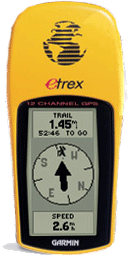

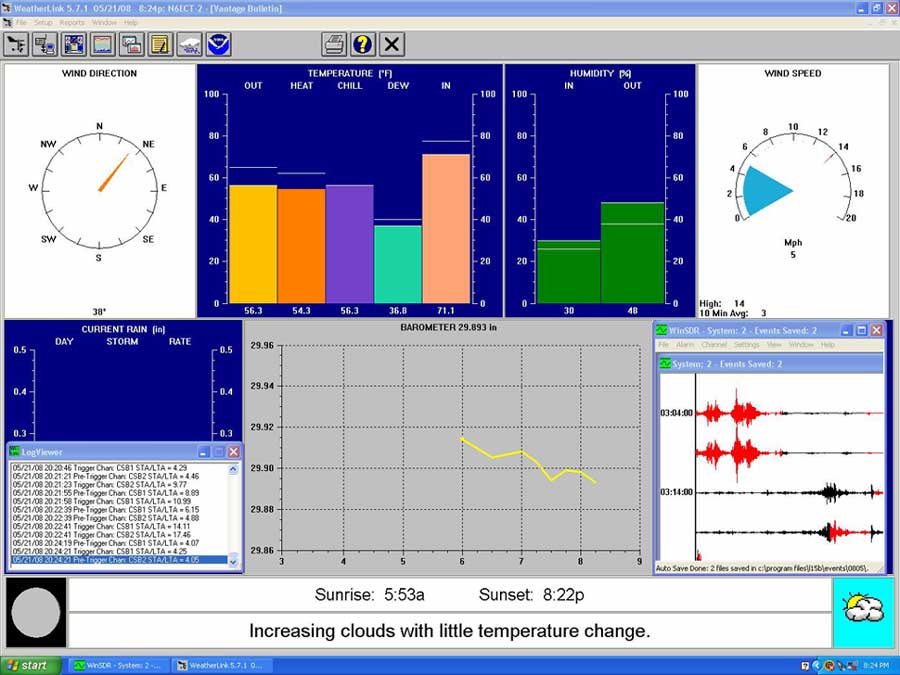
![Weather and Seismic Activity, Cobb [Mountain], California, USA Weather and Seismic Activity, Cobb [Mountain], California, USA](../quakeevents/wx.gif)